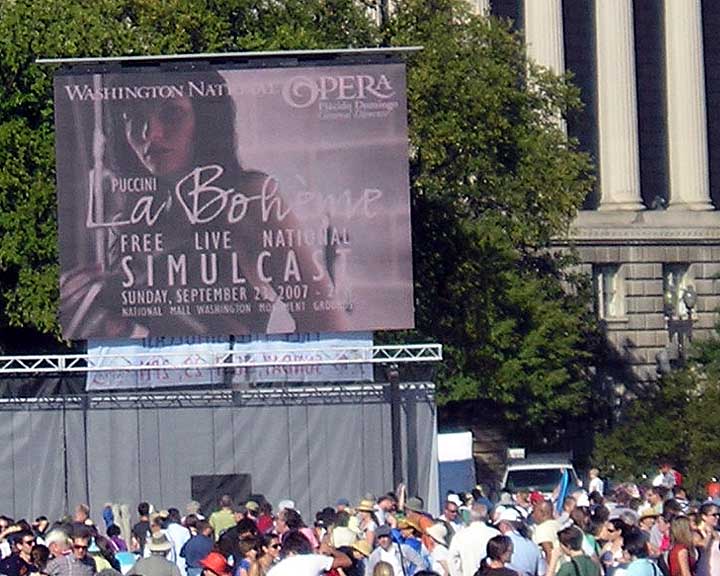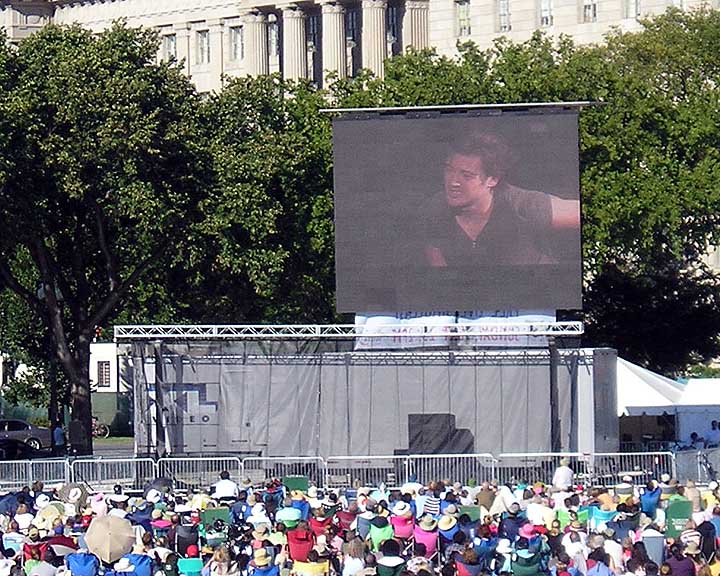Sweeney Todd, The Demon Barber of Fleet Street, a Tim Burton film starring Johnny Depp and Helena Bonham-Carter based on the eponymous Stephen Sondheim musical, opens tonight in Washington at 11:59 p.m. for an after-midnight showing at the movie theater in Chinatown/Gallery Place.
Who wants to go with me?
Thursday, December 20, 2007
Tuesday, December 18, 2007
Three seven ace
Today is the 115th anniversary of the premiere of Tchaikovsky's ballet, The Nutcracker. While I've no Nutcracker plans for this year, last Friday night, while thousands of Washingtonians were attending one of the area's dozens of Nutcracker performances this holiday season, I was attending another Tchaikovsky performance. This performance, while no less magical, was much darker and much longer: we went to see Queen of Spades.
Tchaikovsky wrote several operas, but only Queen of Spades (a/k/a Pique Dame) and Eugene Onegin have any real name recognition. Name recognition is about all either of them have, though, since they are not on the regular rotation, at least in this country, and people don't know the melodies. I was preparing an Eugene Onegin right before I moved to D.C. several years ago and had to withdraw from the production before staging, but until Friday, I had never actually seen a Tchaikovsky opera live.
This particular opera seemed almost Wagnerian to me in terms of its story line and development, not to mention the four hour length! Tchaikovsky's younger brother Modest served as librettist for this work, and he based his words on a short story by famed Russian writer Aleksandr Pushkin. It's the story of a common young man in love with a beautiful young woman who is engaged to be married to a prince. The woman is the granddaughter of an elderly countess called "the queen of spades," who, in her youth, had the secret formula to success in gambling with cards; the young man decides that he also wants the secret to the cards, and gambling becomes his new, overriding obsession. And, in the great tradition of opera, by the end of the show, everybody dies.
The show was performed by the traveling company of the Mariinsky Theater from St. Petersburg, Russia, known in the United States as the Kirov Opera. As Tchaikovsky premiered this work at the Mariinsky in December 1890, it seemed particularly appropriate to watch this opera sung by these Russians.
Having just seen this company sing Otello two nights previous, I saw a lot of the same people in the casts. The principals were all different, but the supporting roles shared many of the same singers. The principals were all very solid singers. The Kirov, however, still operates in the older operatic system where they cast specific voices for parts, not specific singer/actors for parts, as is being done in modern opera in America.
It was this casting technique that caused the problems for me in watching this opera and kept me from fully engaging in the drama. I simply didn't buy the idea of the actors singing Herman and Lisa as young people in love, and thus the show lost credibility. Herman (Vladimir Galouzine) was clearly well into middle age and (while I would never presume to guess the age of a lady!) Lisa (Mlada Khudoley) seemed more matronly to me than innocent, impetuous young maiden. Now, both sang well, but I was sitting on the front row center of the house, so I had to have not only a splendid aural experience, but a splendid visual one, as well.
The sets were very spare, and there was an annoying use of "dancing curtains." It started with two parallel curtains, one black, one white, down on the main curtain line. Once both had parted, though, we saw several other curtains in various locations on stage, including a series that bisected the stage diagonally. Throughout the show, they used these curtains to create different "rooms" and spaces during the action, and some of the curtains were even rigged to move in circular patterns. It was a unique and interesting idea, but they overused the concept and it became quite tiresome by the end of the opera.
Much as in Otello, I had difficulty determining the era of the adjusted story. Pushkin's play was set in the early mid-19th century, but the librettist placed the story in the era of Catherine the Great (late 18th). I don't know where this show was. The costumes seemed to me a mixture of 19th century clothing, but with the men particularly in late 19th. Then we had props—as in Otello—from the present day to confuse matters more. For example, the old countess (Irina Bogacheva), who was so severely done up in black and white age makeup as to look like the caricature of a ghost, wore early 19th century dresses, yet was being wheeled around the stage in a brand new, contemporary wheelchair. Then, during the masquerade ball, when the group was visited by Catherine the Great, we saw a projected silhouette of the empress on the backdrop, but the image looked just like the century-later British empress Victoria.
So, it was in the little things that we found distraction in the production.
Some of the singing was quite fine. I particularly enjoyed the love aria of Yeletsky (Alexander Gergalov). Herman (Vladimir Galouzine) was a very powerful and dramatic singer, and I can see him in any number of other major roles because of his excellent portrayal of a man descending into insanity. It kind of pointed out a Russian staging matter with which I disagree, though, in that their main male characters are very "one note." Wednesday, Otello was "angry" and Friday, Herman was "insane." The characters lack dimension, and that makes it very hard for the audiences to relate to and "like" those characters.
The stage director also missed a couple of good opportunities to advance the drama. He never really highlighted Lisa during her moments on stage, and it was well into the opera before I figured out who the main female character was. In her group scenes, she faded into the crowd; she was never the "star." Then, at the end of the opera, when she realizes that her Herman is more interested in cards and money than her, she's supposed to jump into the river in her despair, but here, she just calmly walked down the embankment. Had I not read the synopsis in the program, I'd not have known that she was committing suicide then. Perhaps she needed a trampoline backstage like Tosca has.
So, Kirov's Queen of Spades definitely gave us an interesting evening. The simple Pushkin story has become a complex opera, and it's an opera that will require a few more viewings to fully understand and appreciate. This production probably is not the best vehicle for learning and appreciating the opera, though. There are limitations that a touring company has, and the way the company addressed those limitations creates dramatic challenges of its own. I did enjoy the evening, though, and it was nice hearing this opera for the first time.
Tchaikovsky wrote several operas, but only Queen of Spades (a/k/a Pique Dame) and Eugene Onegin have any real name recognition. Name recognition is about all either of them have, though, since they are not on the regular rotation, at least in this country, and people don't know the melodies. I was preparing an Eugene Onegin right before I moved to D.C. several years ago and had to withdraw from the production before staging, but until Friday, I had never actually seen a Tchaikovsky opera live.
This particular opera seemed almost Wagnerian to me in terms of its story line and development, not to mention the four hour length! Tchaikovsky's younger brother Modest served as librettist for this work, and he based his words on a short story by famed Russian writer Aleksandr Pushkin. It's the story of a common young man in love with a beautiful young woman who is engaged to be married to a prince. The woman is the granddaughter of an elderly countess called "the queen of spades," who, in her youth, had the secret formula to success in gambling with cards; the young man decides that he also wants the secret to the cards, and gambling becomes his new, overriding obsession. And, in the great tradition of opera, by the end of the show, everybody dies.
The show was performed by the traveling company of the Mariinsky Theater from St. Petersburg, Russia, known in the United States as the Kirov Opera. As Tchaikovsky premiered this work at the Mariinsky in December 1890, it seemed particularly appropriate to watch this opera sung by these Russians.
Having just seen this company sing Otello two nights previous, I saw a lot of the same people in the casts. The principals were all different, but the supporting roles shared many of the same singers. The principals were all very solid singers. The Kirov, however, still operates in the older operatic system where they cast specific voices for parts, not specific singer/actors for parts, as is being done in modern opera in America.
It was this casting technique that caused the problems for me in watching this opera and kept me from fully engaging in the drama. I simply didn't buy the idea of the actors singing Herman and Lisa as young people in love, and thus the show lost credibility. Herman (Vladimir Galouzine) was clearly well into middle age and (while I would never presume to guess the age of a lady!) Lisa (Mlada Khudoley) seemed more matronly to me than innocent, impetuous young maiden. Now, both sang well, but I was sitting on the front row center of the house, so I had to have not only a splendid aural experience, but a splendid visual one, as well.
The sets were very spare, and there was an annoying use of "dancing curtains." It started with two parallel curtains, one black, one white, down on the main curtain line. Once both had parted, though, we saw several other curtains in various locations on stage, including a series that bisected the stage diagonally. Throughout the show, they used these curtains to create different "rooms" and spaces during the action, and some of the curtains were even rigged to move in circular patterns. It was a unique and interesting idea, but they overused the concept and it became quite tiresome by the end of the opera.
Much as in Otello, I had difficulty determining the era of the adjusted story. Pushkin's play was set in the early mid-19th century, but the librettist placed the story in the era of Catherine the Great (late 18th). I don't know where this show was. The costumes seemed to me a mixture of 19th century clothing, but with the men particularly in late 19th. Then we had props—as in Otello—from the present day to confuse matters more. For example, the old countess (Irina Bogacheva), who was so severely done up in black and white age makeup as to look like the caricature of a ghost, wore early 19th century dresses, yet was being wheeled around the stage in a brand new, contemporary wheelchair. Then, during the masquerade ball, when the group was visited by Catherine the Great, we saw a projected silhouette of the empress on the backdrop, but the image looked just like the century-later British empress Victoria.
So, it was in the little things that we found distraction in the production.
Some of the singing was quite fine. I particularly enjoyed the love aria of Yeletsky (Alexander Gergalov). Herman (Vladimir Galouzine) was a very powerful and dramatic singer, and I can see him in any number of other major roles because of his excellent portrayal of a man descending into insanity. It kind of pointed out a Russian staging matter with which I disagree, though, in that their main male characters are very "one note." Wednesday, Otello was "angry" and Friday, Herman was "insane." The characters lack dimension, and that makes it very hard for the audiences to relate to and "like" those characters.
The stage director also missed a couple of good opportunities to advance the drama. He never really highlighted Lisa during her moments on stage, and it was well into the opera before I figured out who the main female character was. In her group scenes, she faded into the crowd; she was never the "star." Then, at the end of the opera, when she realizes that her Herman is more interested in cards and money than her, she's supposed to jump into the river in her despair, but here, she just calmly walked down the embankment. Had I not read the synopsis in the program, I'd not have known that she was committing suicide then. Perhaps she needed a trampoline backstage like Tosca has.
So, Kirov's Queen of Spades definitely gave us an interesting evening. The simple Pushkin story has become a complex opera, and it's an opera that will require a few more viewings to fully understand and appreciate. This production probably is not the best vehicle for learning and appreciating the opera, though. There are limitations that a touring company has, and the way the company addressed those limitations creates dramatic challenges of its own. I did enjoy the evening, though, and it was nice hearing this opera for the first time.
Thursday, December 13, 2007
Russian Verdi
Every now and then in my opera singing and spectating careers, I find one transcendent performance, one hauntingly memorable singer. Last night was one of those times.
Joined by my friend Peter (himself a former music critic for a major urban daily newspaper) and his partner, I heard the Kirov Opera from St. Petersburg, Russia, present Verdi's Otello at the John F. Kennedy Center for the Performing Arts here in Washington. It was a rather odd production, with the staging and sets centered around a large lighthouse and a performance that opened with the lighthouse beacon shining painfully brightly into the audience's eyes.
The true beacon of the evening, though, was Irina Mataeva and her sensitive and beautiful portrayal of Desdemona, the unfortunate wife of Otello. Miss Mataeva is a very beautiful, slender, young woman, perfectly cast for the role. Her voice is powerful and dramatic, yet her acting skills and vocal nuance allowed her to be the vulnerable victim of circumstances. Her emotional pain could be felt, even when the production got in the way, such as in her fourth act "Ave Maria," when the production put her in an intenable location. In the immediately previous scene, though, her "Song to the Willow" was touching and compelling.
Avgust Amonov sang Otello and Edem Umerov sang Iago. Otello normally is a four act opera; the Kirov chose to combine acts 1 and 2 into one long act. It wasn't until the end of that long first act that I felt Amonov and Umerov's voices blended into a powerful dramatic force, but, alas, that was really the only time. Umerov spent his time skulking around and Amonov spent his time knocking things over. I enjoyed more the performance of Sergey Semishkur in the smaller role of Cassio, the young lieutenant Iago tries to set up as Desdemona's alleged paramour.
Valery Gergiev conducted the Kirov Orchestra. They were particularly fine, although Gergiev often had them playing at surprisingly loud volumes when singers were singing. It was an exciting orchestral performance, though, especially at the end of act 2 (the opera's act 3). While they did have a few problems in the opening choruses staying precisely together with the orchestra, the Kirov Opera Chorus was solid.
The concept for this production is unusual, and I still haven't quite figured it out. Male costuming seemed to be mid-19th century, whilst female lead costuming was early 20th century. Clearly, they were "updating" from Verdi's intended 15th century time frame. Verdi's direction also put the set by or in a castle. Here, a huge lighthouse dominated the upstage center, with long, white, stuccoed walls on the diagonal leading the eye along their V to the lighthouse. During the opera's opening storm sequence, the lighthouse beacon beamed very bright light into the eyes of the audience. When the action goes "in" the castle, a cherry wood desk and credenza with hutch that look much like office furniture from the "traditional" collection at Office Depot are added to the stage right half of the stage with a rather contemporary large "ceiling" light fixture suspended on a wire over the desk.
The final act of the opera is supposed to take place in Desdemona's bedchamber. The first portion ("Song to the Willow") takes place far stage right in front of a black backdrop in front of the curtainline. When Desdemona begins her transition to prayer ("Ave Maria"), she leaves that set, the stage left half of the black backdrop raises to reveal a close-up of the top of the lighthouse, and she emerges on what is a raised level above the stage on the lighthouse; Otello soon enters the lighthouse yet one more level above. Why? Exactly what the production designers wanted to accomplish escaped me.
I enjoyed the evening. The audience's reaction, though, I felt was oddly restrained and polite. During the curtain calls, Mataeva was the only singer greeted with cheers. A number of audience members chose to stand when Gergiev came on, possibly in tribute to the orchestra, but it did not seem a majority. As the principal cast all came on stage in front of the black backdrop and remained there for multiple bows, it was a little awkward, and I think I felt some impatience from the audience for them to exit more quickly than they did. Nevertheless, this is an interesting production, and there still remains a Sunday afternoon matineee for those who wish to see it.
Joined by my friend Peter (himself a former music critic for a major urban daily newspaper) and his partner, I heard the Kirov Opera from St. Petersburg, Russia, present Verdi's Otello at the John F. Kennedy Center for the Performing Arts here in Washington. It was a rather odd production, with the staging and sets centered around a large lighthouse and a performance that opened with the lighthouse beacon shining painfully brightly into the audience's eyes.
The true beacon of the evening, though, was Irina Mataeva and her sensitive and beautiful portrayal of Desdemona, the unfortunate wife of Otello. Miss Mataeva is a very beautiful, slender, young woman, perfectly cast for the role. Her voice is powerful and dramatic, yet her acting skills and vocal nuance allowed her to be the vulnerable victim of circumstances. Her emotional pain could be felt, even when the production got in the way, such as in her fourth act "Ave Maria," when the production put her in an intenable location. In the immediately previous scene, though, her "Song to the Willow" was touching and compelling.
Avgust Amonov sang Otello and Edem Umerov sang Iago. Otello normally is a four act opera; the Kirov chose to combine acts 1 and 2 into one long act. It wasn't until the end of that long first act that I felt Amonov and Umerov's voices blended into a powerful dramatic force, but, alas, that was really the only time. Umerov spent his time skulking around and Amonov spent his time knocking things over. I enjoyed more the performance of Sergey Semishkur in the smaller role of Cassio, the young lieutenant Iago tries to set up as Desdemona's alleged paramour.
Valery Gergiev conducted the Kirov Orchestra. They were particularly fine, although Gergiev often had them playing at surprisingly loud volumes when singers were singing. It was an exciting orchestral performance, though, especially at the end of act 2 (the opera's act 3). While they did have a few problems in the opening choruses staying precisely together with the orchestra, the Kirov Opera Chorus was solid.
The concept for this production is unusual, and I still haven't quite figured it out. Male costuming seemed to be mid-19th century, whilst female lead costuming was early 20th century. Clearly, they were "updating" from Verdi's intended 15th century time frame. Verdi's direction also put the set by or in a castle. Here, a huge lighthouse dominated the upstage center, with long, white, stuccoed walls on the diagonal leading the eye along their V to the lighthouse. During the opera's opening storm sequence, the lighthouse beacon beamed very bright light into the eyes of the audience. When the action goes "in" the castle, a cherry wood desk and credenza with hutch that look much like office furniture from the "traditional" collection at Office Depot are added to the stage right half of the stage with a rather contemporary large "ceiling" light fixture suspended on a wire over the desk.
The final act of the opera is supposed to take place in Desdemona's bedchamber. The first portion ("Song to the Willow") takes place far stage right in front of a black backdrop in front of the curtainline. When Desdemona begins her transition to prayer ("Ave Maria"), she leaves that set, the stage left half of the black backdrop raises to reveal a close-up of the top of the lighthouse, and she emerges on what is a raised level above the stage on the lighthouse; Otello soon enters the lighthouse yet one more level above. Why? Exactly what the production designers wanted to accomplish escaped me.
I enjoyed the evening. The audience's reaction, though, I felt was oddly restrained and polite. During the curtain calls, Mataeva was the only singer greeted with cheers. A number of audience members chose to stand when Gergiev came on, possibly in tribute to the orchestra, but it did not seem a majority. As the principal cast all came on stage in front of the black backdrop and remained there for multiple bows, it was a little awkward, and I think I felt some impatience from the audience for them to exit more quickly than they did. Nevertheless, this is an interesting production, and there still remains a Sunday afternoon matineee for those who wish to see it.
Entitlements
What is it about people today that makes so many so extremely egocentric and demanding? Why do so many people today feel they are entitled to things without working for them?
Last night I witnessed a disturbing incident of such presumed entitlement. I was standing in line at the "will call" window at the box office to pick up my tickets for the evening's performance. An expensively dressed young woman was standing at one of the windows throwing a major fit because she didn't like the location of the tickets she was getting and she thought the box office should upgrade them to a better location. What was particularly interesting is that they were $98 (each) tickets and she wanted to be moved to the $175 (each) section; further, she had not bought and paid for these tickets; they were "comps"—free tickets that had been given to her from amongst unsold ticket inventory. After this young woman thoroughly berated the window clerk for not upgrading her, she got a box office manager to come over. The manager, with far greater patience and politeness than I would have shown, calmly explained again to her that these were free tickets, that the marketing office had chosen them not the box office, and that he would be happy to upgrade her two tickets to the section she wanted for $350. She snatched away the free tickets, saying in no uncertain terms that she was not about to give them any money, and stormed off to the performance. When I saw her again in the auditorium, her free tickets were better than mine! I certainly hope that they blacklist her and never, ever give her another comp ticket.
I was always raised to be grateful for gifts and favors, especially when they inconvenience the giver. Yet, people today feel free to make further demands on givers and do not seem to feel the need to extend what I consider to be common courtesy.
Am I just hopelessly old fashioned and out of touch?
Last night I witnessed a disturbing incident of such presumed entitlement. I was standing in line at the "will call" window at the box office to pick up my tickets for the evening's performance. An expensively dressed young woman was standing at one of the windows throwing a major fit because she didn't like the location of the tickets she was getting and she thought the box office should upgrade them to a better location. What was particularly interesting is that they were $98 (each) tickets and she wanted to be moved to the $175 (each) section; further, she had not bought and paid for these tickets; they were "comps"—free tickets that had been given to her from amongst unsold ticket inventory. After this young woman thoroughly berated the window clerk for not upgrading her, she got a box office manager to come over. The manager, with far greater patience and politeness than I would have shown, calmly explained again to her that these were free tickets, that the marketing office had chosen them not the box office, and that he would be happy to upgrade her two tickets to the section she wanted for $350. She snatched away the free tickets, saying in no uncertain terms that she was not about to give them any money, and stormed off to the performance. When I saw her again in the auditorium, her free tickets were better than mine! I certainly hope that they blacklist her and never, ever give her another comp ticket.
I was always raised to be grateful for gifts and favors, especially when they inconvenience the giver. Yet, people today feel free to make further demands on givers and do not seem to feel the need to extend what I consider to be common courtesy.
Am I just hopelessly old fashioned and out of touch?
Tuesday, December 4, 2007
It's a contest!
Want to win a free ticket?
I have been fortunate to be able to purchase two excellent tickets—front row aisle, center orchestra—to the Friday, December 14 performance of The Queen of Spades, an opera by Pyotr Ilyich Tschaikovsky based on the novella of the same name by Aleksandr Pushkin, to be sung at the John F. Kennedy Center for the Performing Arts, by the famed Kirov Opera of the Mariinsky Theater from St. Petersburg, Russia.
I am so excited!
So, in order to have a perfect evening, I've decided to have a contest for my evening's companion. This contest is open to anyone, male or female, young or old, who might be interested in accompanying me to this event and hearing what promises to be a fantastic and memorable performance. Since it's a Friday evening, some of you who are out of town might want to consider coming in to Washington for the night/weekend.
How to enter? Write me here by midnight Eastern standard time Monday, December 10, and tell me: why you want to go? why should I choose you? I'll pick the winner early next week.
This contest is not limited to blog people, so if you know someone who'd like to go, get their information and make the entry for them. I love meeting new people!
For planning purposes, curtain is at 7:30. I like to get to the Kennedy Center a little early so we can cocktail a bit before going into the Opera House. Depending upon schedules, we might have a light supper beforehand. I'll be wearing a normal suit and tie—this isn't a formal occasion—so you can dress accordingly. The opera is sung in the original Russian, but they project the English translations as surtitles above the stage, so you'll have no trouble understanding what is going on. Afterwards, we'll probably walk over to Georgetown for a little late night snack or dessert.
Don't delay! Do your entry today!
I have been fortunate to be able to purchase two excellent tickets—front row aisle, center orchestra—to the Friday, December 14 performance of The Queen of Spades, an opera by Pyotr Ilyich Tschaikovsky based on the novella of the same name by Aleksandr Pushkin, to be sung at the John F. Kennedy Center for the Performing Arts, by the famed Kirov Opera of the Mariinsky Theater from St. Petersburg, Russia.
I am so excited!
So, in order to have a perfect evening, I've decided to have a contest for my evening's companion. This contest is open to anyone, male or female, young or old, who might be interested in accompanying me to this event and hearing what promises to be a fantastic and memorable performance. Since it's a Friday evening, some of you who are out of town might want to consider coming in to Washington for the night/weekend.
How to enter? Write me here by midnight Eastern standard time Monday, December 10, and tell me: why you want to go? why should I choose you? I'll pick the winner early next week.
This contest is not limited to blog people, so if you know someone who'd like to go, get their information and make the entry for them. I love meeting new people!
For planning purposes, curtain is at 7:30. I like to get to the Kennedy Center a little early so we can cocktail a bit before going into the Opera House. Depending upon schedules, we might have a light supper beforehand. I'll be wearing a normal suit and tie—this isn't a formal occasion—so you can dress accordingly. The opera is sung in the original Russian, but they project the English translations as surtitles above the stage, so you'll have no trouble understanding what is going on. Afterwards, we'll probably walk over to Georgetown for a little late night snack or dessert.
Don't delay! Do your entry today!
Exploring the Belmont Mansion

In anticipation of playing/singing for a lodge installation of officers next week, I wanted to see the meeting venue and play the instrument(s) in question before showing up. This particular ceremony is going to take place in the Belmont Mansion, now the international headquarters building of the Order of the Eastern Star, a Masonic-affiliated group for women.
The ceremony will be in the ballroom, and I'll be playing a gold-covered 1911 Steinway B. I'd also considered playing the organ, but it's actually a huge thing for the space, and not at all subtle—the pipe chambers open into the grand staircase, and the instrument blasts the entire house.
The international secretary and her husband actually live in the house as resident caretakers. I'd made an appointment with them to look around and play last night. After I'd played a little and sang a bit to note the acoustic, they revealed that the Most Worthy Grand Matron (think "international president") was downstairs, and, since she coincidentally is also from Oklahoma, they wanted me to meet her. So, I acquiesced. But, then, the husband got on a loudspeaker and told everyone in the house to come up to the ballroom immediately! It turns out they were having some kind of international officers meeting, and there were quite a few people downstairs.
 Well, the Most Worthy Grand Matron and I had actually met once before, years ago. When I was International DeMolay of the Year, I made an official visitation to the Grand Chapter meeting of the Oklahoma Eastern Stars, and she was just then starting the progressive grand line (state offices) in Oklahoma.
Well, the Most Worthy Grand Matron and I had actually met once before, years ago. When I was International DeMolay of the Year, I made an official visitation to the Grand Chapter meeting of the Oklahoma Eastern Stars, and she was just then starting the progressive grand line (state offices) in Oklahoma.She happens to be Indian, and one of her little things she likes to do at Star meetings is the Lord's Prayer in Indian sign language. I had to play and sing for her while she did that for the group. Then, they wanted me to sing something else, so I had to find a little Mozart aria in what little music I had with me. Keep in mind, I'd only gone up there to test the piano, not play/sing a concert!
After all that was over, Ryan (who no doubt was probably bored to death by this point) and I had to chat with people, and then they gave us a brief tour of the public rooms of the building. It's quite a nice place, and hard to believe that people actually built and used it for a private residence a century ago.
Here are a few pictures of the building. Above, I'm at the piano in the end of the ballroom. We forgot to get a pic of the ballroom and its big dome and skylight. The other rooms are pretty, too, though.
The entry and grand staircase:


The music room and the butler's pantry:
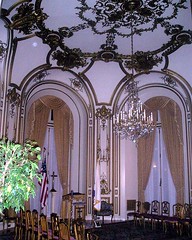
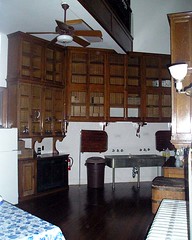
The state dining room:

The gold room:
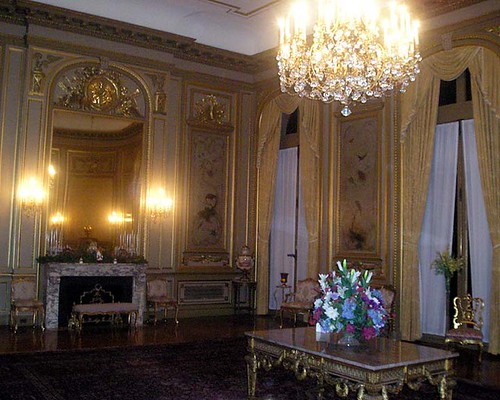
Monday, December 3, 2007
Kennedy Center Honors
Ryan's social forwardness at the allegedly high security Kennedy Center Honors worked out quite well for him tonight. The President left before he could say hi, but he managed to meet a bunch of other celebs, elbowing his way past their bodyguards and handlers. He's just home with a load of photos to add to his collection of celebrity pictures. Do you recognize any of these people?







Incidentally, the top picture was taken by Sen. Chuck Schumer....who was talking with the Speaker when Ryan interrupted them for a photo request. And Ed Schlossberg (Mr. Caroline Kennedy) isn't very excited when people ask him to take a picture of them with his wife. LOL
By the way, Madame Speaker is surprisingly frugal! Odd for a Democrat, eh? She wore the exact same dress tonight that she wore to the state dinner last May in honor of Queen Elizabeth. Looks like the same nasty old pearls and earrings, too. Don't we pay that poor millionnairess enough money in her job? At least she wasn't wearing a pant suit.
 I hear furs are in in a big way! And Diana Ross and Aretha Franklin (plus Aretha's husband) were all wearing white full-length furs at the gala. Lots of other "normal" black and brown minks of all shapes and sizes there, too. I've always wanted a full-length mink coat (almost as much as an opera cape), but the only guys I've ever seen in them have been Luciano Pavarotti and Wayne Gretzky, and both of them live(d) in colder climates than Oklahoma or D.C.
I hear furs are in in a big way! And Diana Ross and Aretha Franklin (plus Aretha's husband) were all wearing white full-length furs at the gala. Lots of other "normal" black and brown minks of all shapes and sizes there, too. I've always wanted a full-length mink coat (almost as much as an opera cape), but the only guys I've ever seen in them have been Luciano Pavarotti and Wayne Gretzky, and both of them live(d) in colder climates than Oklahoma or D.C.
Here're some shots of the tables in the Grand Foyer and the menu for the post-gala supper.
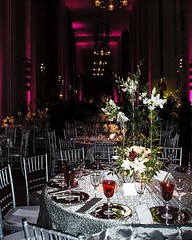
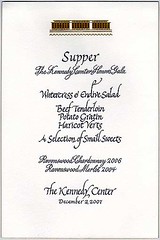
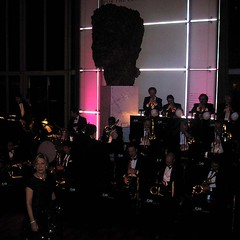







Incidentally, the top picture was taken by Sen. Chuck Schumer....who was talking with the Speaker when Ryan interrupted them for a photo request. And Ed Schlossberg (Mr. Caroline Kennedy) isn't very excited when people ask him to take a picture of them with his wife. LOL
By the way, Madame Speaker is surprisingly frugal! Odd for a Democrat, eh? She wore the exact same dress tonight that she wore to the state dinner last May in honor of Queen Elizabeth. Looks like the same nasty old pearls and earrings, too. Don't we pay that poor millionnairess enough money in her job? At least she wasn't wearing a pant suit.
 I hear furs are in in a big way! And Diana Ross and Aretha Franklin (plus Aretha's husband) were all wearing white full-length furs at the gala. Lots of other "normal" black and brown minks of all shapes and sizes there, too. I've always wanted a full-length mink coat (almost as much as an opera cape), but the only guys I've ever seen in them have been Luciano Pavarotti and Wayne Gretzky, and both of them live(d) in colder climates than Oklahoma or D.C.
I hear furs are in in a big way! And Diana Ross and Aretha Franklin (plus Aretha's husband) were all wearing white full-length furs at the gala. Lots of other "normal" black and brown minks of all shapes and sizes there, too. I've always wanted a full-length mink coat (almost as much as an opera cape), but the only guys I've ever seen in them have been Luciano Pavarotti and Wayne Gretzky, and both of them live(d) in colder climates than Oklahoma or D.C.Here're some shots of the tables in the Grand Foyer and the menu for the post-gala supper.



Friday, November 30, 2007
Radio City Christmas 75
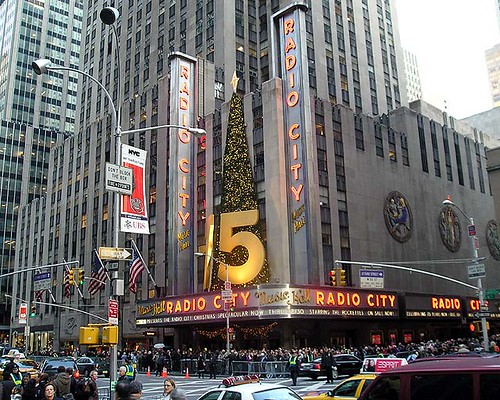
As we approach the Christmas season, what can be more festive than an afternoon with the Radio City Music Hall Rockettes and their Christmas Spectacular show?
All I can say is "wow."
What's more exciting, this is the 75th anniversary of the very first annual Christmas show, so I think they made it a little extra-special spectacular this year. It must be exhausting to be a Rockette, since they do a minimum of three shows a day to as many as five, from mid-November through New Years. I'm sure they must be double cast, but still, dancing more than one 90-minute show per day, every day, would be a challenge!
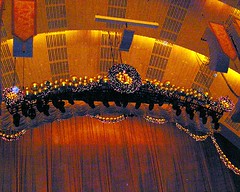
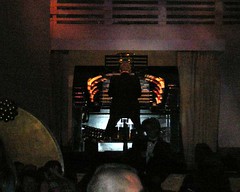
The show is in the beautiful and spectacular Radio City Music Hall, a gem of American Modernist architecture from the 1930s. The stage is huge at over 100 feet wide, there are three balconies, and the auditorium is said to be the largest indoor theater in the world, seating a little over 6,000. And, Ian and my seats were perfect Wednesday afternoon, just a little to the left of center in the middle of the orchestra seating, giving us wonderful views of the full stage.
Before and after the show, organists at huge organ consoles along the side walls flanking the stage played duet holiday music on the enormous "Mighty Wurlitzer" theater organ. I was kind of amused to see the organists' shoes spiked with bands of rhinestones to catch the spotlights as they played and moved their feet.
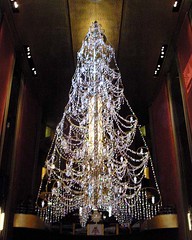 There's a beautiful, three-story-tall, crystal Christmas tree in the soaring lobby of the music hall, and there are all kinds of souvenirs for the show and for the Rockettes. They sold cocktails with glowstick stirrers, and I was surprised that they allowed drinks and food in the auditorium (especially those $10 little bags of cotton candy being sold to the kids—who'll clean up the mess?).
There's a beautiful, three-story-tall, crystal Christmas tree in the soaring lobby of the music hall, and there are all kinds of souvenirs for the show and for the Rockettes. They sold cocktails with glowstick stirrers, and I was surprised that they allowed drinks and food in the auditorium (especially those $10 little bags of cotton candy being sold to the kids—who'll clean up the mess?).But, on to the show! I wish I could have taken some pictures for you, but photography was prohibited, of course. Plus, there was no way to adequately capture everything that was happening to give you any kind of idea of the great pageantry and the scale or scope of this event.
They opened with the Rockettes dressed as reindeer at the North Pole, ultimately doing their signature kickline. Throughout the show, the precision and perfectly, perfectly straight dance lines of the Rockettes just astounded me. Even the military marching in formation doesn't get lines like these.
After we meet Santa Claus, he decides to go to New York City and instructs the audience to put on their 3-D glasses to come along for the voyage. A special screen drops down over the front of the stage, and we all go on a special effects animated tour across the tundra, through the skies, and up and down the narrow streets of New York with all the amazement and wonder that 3-D can bring!
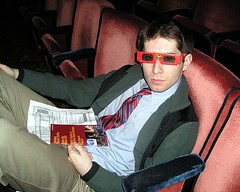 The show is a series of a dozen "scenes" starring the Rockettes and with a cast of singer-actors to help maintain continuity while the dancers change costumes and prepare for the next scene. Some of the scenes were absolutely magical. We got a holiday tour of downtown Manhattan with the Rockettes on a real double-decker bus that drove around the stage and with an actual ice skating rink and skaters that came up from the stage traps. There was an abridged version of The Nutcracker with a young girl ballerina as Clara, and her magical nutcrackers and characters were all danced en pointe by bears, including some pandas for the Chinese dance and a particularly large and divaesque bear as the Sugar Plum Fairy. The parade of the wooden soldiers marched forth (this was only the 74th year for them!). There's a nativity scene with a couple of live camels and a donkey and a flown angel with big, flapping wings.
The show is a series of a dozen "scenes" starring the Rockettes and with a cast of singer-actors to help maintain continuity while the dancers change costumes and prepare for the next scene. Some of the scenes were absolutely magical. We got a holiday tour of downtown Manhattan with the Rockettes on a real double-decker bus that drove around the stage and with an actual ice skating rink and skaters that came up from the stage traps. There was an abridged version of The Nutcracker with a young girl ballerina as Clara, and her magical nutcrackers and characters were all danced en pointe by bears, including some pandas for the Chinese dance and a particularly large and divaesque bear as the Sugar Plum Fairy. The parade of the wooden soldiers marched forth (this was only the 74th year for them!). There's a nativity scene with a couple of live camels and a donkey and a flown angel with big, flapping wings.One of the most amazing technical accomplishments of this show happened to be the backdrops for each of the scenes. There was one for the whole show: an enormous high definition flat panel television screen! The colors just popped from that HD TV and it allowed for all kinds of animation and film special effects. They did a lot of lighting and projection, too, making use of the entire auditorium and the walls and ceilings of the auditorium. Also, at one point, when Santa is demonstrating his magic to convince a skeptical fourteen-year-old that he really exists, he makes it snow on stage.....well, I've done enough shows to know how the stagehands do stage snow.....but this Santa was especially magic, because not only did he make it snow on stage, he made it snow out in the house! Several snowflakes hit me, and they were real snow!
The Radio City Music Hall Rockettes Christmas Spectacular is an American treasure. I wish everyone could make the pilgrimage to New York at least once in their lifetime to see this show—it's well worth the trip!
Thursday, November 29, 2007
Strike's over
Just in from New York City and I'm glad to see my trip was successful!
As we were walking around Times Square and the theater district around Broadway this evening, I told three or four lines of stagehands picketers to get back to work. Apparently, they listened to me, since when I got home, I found the news of a union compromise and settlement.
http://www.nytimes.com/2007/11/29/theater/29broadway.html?_r=1&ex=1354078800&en=4e599847fe223a8a&ei=5088&partner=rssnyt&emc=rss&oref=slogin
Now, you all can go to Broadway and see a show. You needn't thank me. The smiles of happy little children is all the thanks I need.
As we were walking around Times Square and the theater district around Broadway this evening, I told three or four lines of stagehands picketers to get back to work. Apparently, they listened to me, since when I got home, I found the news of a union compromise and settlement.
http://www.nytimes.com/2007/11/29/theater/29broadway.html?_r=1&ex=1354078800&en=4e599847fe223a8a&ei=5088&partner=rssnyt&emc=rss&oref=slogin
Now, you all can go to Broadway and see a show. You needn't thank me. The smiles of happy little children is all the thanks I need.
Saturday, November 24, 2007
Mélange des danses
It's always interesting how Washington, D.C., has a way of helping people see just how small the world is.
I was born in a town back in Oklahoma that straddles the border between the Osage Indian Nation and the Cherokee Indian Nation. For several years, I lived out in the country on the Osage, and I love going to the annual Osage religious ceremonial dances in the summer. Well, the Osages have three beloved women—all in their 80s now—who were internationally famous ballerinas. One of those Osage ballerinas is Maria Tallchief, the first prima ballerina of the New York City Ballet, the country's preeminent ballet company. During her reign there, she fell in love with and married George Balanchine, one of the most famous ballet choreographers of the 20th century who was also the founder and director of NYCB.
Balanchine, as much as his name is spoken of in awe in ballet circles, had this bad habit of falling in love with his latest beautiful and talented ballerina and then creating his best work for them. His marriage to Maria only lasted about five or six years, and she ended up leaving NYCB because of another beautiful and talented ballerina who joined NYCB in 1961, Suzanne Farrell. Well, he fell in love with her, but Miss Farrell ended up marrying another dancer because Balanchine was married to yet another ballerina at the time; I think it's probably the fact that she was never an ex-wife that allowed Farrell to maintain her close friendship and association with Balanchine. She had a long, distinguished, international career through NYCB, and dozens of major works were created and choreographed specifically for her. At his death, he willed her the rights to the choreography of several of his great works, and she has since worked with the George Balanchine Trust.
Then, in 2000, Farrell formally created the Suzanne Farrell Ballet, the resident ballet company of the Kennedy Center in Washington. We went to one of their dance concerts last night at the Kennedy Center, a dance concert that was based entirely on the works of George Balanchine. And hence we come full circle to see the small world.
It was an interesting concert, to say the least. They presented five ballets in three acts.
The evening opened with Bugaku, a stylized representation of a Japanese marriage. Some very unusual music by Toshiro Mayuzumi made up the accompaniment, played by the Kennedy Center Opera House Orchestra with Ron Matson conducting. Mayuzumi was a fan of blending the avant garde of modern 20th century music with Japanese sensibilities.
The set was a striking three-sided rectangular, red barre with Japanese architectural lines that was suspended by thick ropes. Costumes were gauzy white overlays that trailed behind both male and female dancers as they moved. In the short first scene, the women wore classical tutus such as the one in the photograph that graces the cover of this month's Kennedy Center Playbill.
The dance was rather slow, with movements and postures designed to evoke Japanese theater and geisha traditions. At times, that stylized movement seemed almost robotic to me.
In act 2, they opened with Ballade, set to the music of Gabriel Fauré with a very romantic piano and orchestra score. This ballet featured their up and coming star ballerina Bonnie Pickard, partnered with principal Runqiao Du (who we would later see in the fourth ballet pas de deux). The company danced on a bare stage with only a cyclorama backdrop illuminated in midnight blue.
The third ballet was my favorite of the evening. Pithoprakta is a starkly modern study in binary black and white, complete with black and white costumes and a large backdrop with mathematical numbers and a graph. Music was by 20th century Greek composer Iannis Xenakis, from his work Pithoprakta. Xenakis originally trained and worked as an architect before turning to musical composition, and that mathematical nature can be heard in his music; this work has a lot of random plucked notes and is freeform, even for modernism. The dancers were very angular in their movements and much of the company rolled around a lot on the floor. We particularly noticed featured dancer, soloist Matthew Prescott, who's a tall, tossled-headed blond man who was required to dance a very physical performance.
Tchaikovsky's Meditation, Op. 42, from his Souvenir d'un Lieu Cher provided the backdrop for the fourth ballet and opening of the third act, Meditation, a simple pas de deux for principals Du and Natalia Magnicaballi. This was one of those ballets that Balenchine created especially for Farrell. While I think the focus was to be on the male dancer, the real work and choreography was all with the female dancer. They also danced to a bare stage, and Du was costumed in street clothes and Magnicaballi was in a simple, unadorned, romantic tutu.
The final work of the evening used Arnold Schoenberg's orchestration of Johannes Brahms' Piano Quartet No. 1 in G minor, Op. 25, as the background for a ballet called, simply, Fourth Movement of Brahms-Schoenberg Quartet. This was their big company finale number, starring Miss Pickard and Bulgarian principal dancer Momchil Mladenov. It seems to have been inspired by Eastern European folk dance, and the costumes had a Hungarian look to them. Mladenov was the first male dancer of the evening to have any particularly challenging choreography, and Pickard was very well received with her dancing en pointe.
We sat in an interesting location on the third row of the opera house in the center of the left side orchestra section. We were surrounded by a bunch of balletomanes who knew dance and had definite opinions. There was a very elderly couple to my right who shared many of my thoughts and opinions, while a man in front of me was incredulous that I liked the third ballet better than the first. I also ran into someone on the first row who was recruiting me to work again with the Kirov Ballet when they come back to Washington in January, and then he looked at me and queried, "Have you gained weight?" Not wanting to admit it, I blamed it on my sweater.....you know how sweaters can make you look bigger....it's true! Really! However, if I'm going to try to dance again, I'm going to have to go on a massive weight loss campaign between now and then, since even the last time I danced, I was too heavy, and my feet and knees were killing me!
Anyway, it's nice to see someone working on preserving the Balanchine choreography. The women were all fine technical dancers, though none of them had me enraptured (that's hard to do, though, with these short ballets—you need a full-length production to develop the character). I was, though, a bit disappointed with the men, though disappointed is probably too strong a word and it really wasn't their fault.
Farrell certainly does not expect much from her men. Most of the time, she just has her men moving in rhythm, promenading, and partnering (lifting the girls). In the second ballet, the guy had one little sauté (small leap), and in the fifth, the danseur did some entrechats (jump with feet beating the air), and some single tours en l'air (spin in the air) and pirouettes, but not a single grand jeté (splits in mid-air) and not even any real tours chaînés déboulés. There were no "star" moments for the men.
I was trying to explain this to Ryan (who'd never before seen live ballet) using ice skating analogies. You know how when you watch those Olympic competitions and the really really top skaters do a "triple lutz" or a "triple toe loop," and if something goes wrong and the skater only does a double—or, heaven forbid, a single!—the commentators just jump all over it? That's how I felt with the men's dance performances, except they weren't scripted to do anything but singles, and very few of those to begin with.
The ballerinas, though, had plenty to do, and I'd imagine that Farrell—having been an international star herself—is very demanding with them. They, at least, got the opportunity to shine and display their grace, strength, and balance.
While I tend to prefer full-length productions, it will be interesting to watch the Suzanne Farrell Ballet, and I'm sure I'll be going to many of their concerts in the future.
I was born in a town back in Oklahoma that straddles the border between the Osage Indian Nation and the Cherokee Indian Nation. For several years, I lived out in the country on the Osage, and I love going to the annual Osage religious ceremonial dances in the summer. Well, the Osages have three beloved women—all in their 80s now—who were internationally famous ballerinas. One of those Osage ballerinas is Maria Tallchief, the first prima ballerina of the New York City Ballet, the country's preeminent ballet company. During her reign there, she fell in love with and married George Balanchine, one of the most famous ballet choreographers of the 20th century who was also the founder and director of NYCB.
Balanchine, as much as his name is spoken of in awe in ballet circles, had this bad habit of falling in love with his latest beautiful and talented ballerina and then creating his best work for them. His marriage to Maria only lasted about five or six years, and she ended up leaving NYCB because of another beautiful and talented ballerina who joined NYCB in 1961, Suzanne Farrell. Well, he fell in love with her, but Miss Farrell ended up marrying another dancer because Balanchine was married to yet another ballerina at the time; I think it's probably the fact that she was never an ex-wife that allowed Farrell to maintain her close friendship and association with Balanchine. She had a long, distinguished, international career through NYCB, and dozens of major works were created and choreographed specifically for her. At his death, he willed her the rights to the choreography of several of his great works, and she has since worked with the George Balanchine Trust.
Then, in 2000, Farrell formally created the Suzanne Farrell Ballet, the resident ballet company of the Kennedy Center in Washington. We went to one of their dance concerts last night at the Kennedy Center, a dance concert that was based entirely on the works of George Balanchine. And hence we come full circle to see the small world.
It was an interesting concert, to say the least. They presented five ballets in three acts.
The evening opened with Bugaku, a stylized representation of a Japanese marriage. Some very unusual music by Toshiro Mayuzumi made up the accompaniment, played by the Kennedy Center Opera House Orchestra with Ron Matson conducting. Mayuzumi was a fan of blending the avant garde of modern 20th century music with Japanese sensibilities.
The set was a striking three-sided rectangular, red barre with Japanese architectural lines that was suspended by thick ropes. Costumes were gauzy white overlays that trailed behind both male and female dancers as they moved. In the short first scene, the women wore classical tutus such as the one in the photograph that graces the cover of this month's Kennedy Center Playbill.
The dance was rather slow, with movements and postures designed to evoke Japanese theater and geisha traditions. At times, that stylized movement seemed almost robotic to me.
In act 2, they opened with Ballade, set to the music of Gabriel Fauré with a very romantic piano and orchestra score. This ballet featured their up and coming star ballerina Bonnie Pickard, partnered with principal Runqiao Du (who we would later see in the fourth ballet pas de deux). The company danced on a bare stage with only a cyclorama backdrop illuminated in midnight blue.
The third ballet was my favorite of the evening. Pithoprakta is a starkly modern study in binary black and white, complete with black and white costumes and a large backdrop with mathematical numbers and a graph. Music was by 20th century Greek composer Iannis Xenakis, from his work Pithoprakta. Xenakis originally trained and worked as an architect before turning to musical composition, and that mathematical nature can be heard in his music; this work has a lot of random plucked notes and is freeform, even for modernism. The dancers were very angular in their movements and much of the company rolled around a lot on the floor. We particularly noticed featured dancer, soloist Matthew Prescott, who's a tall, tossled-headed blond man who was required to dance a very physical performance.
Tchaikovsky's Meditation, Op. 42, from his Souvenir d'un Lieu Cher provided the backdrop for the fourth ballet and opening of the third act, Meditation, a simple pas de deux for principals Du and Natalia Magnicaballi. This was one of those ballets that Balenchine created especially for Farrell. While I think the focus was to be on the male dancer, the real work and choreography was all with the female dancer. They also danced to a bare stage, and Du was costumed in street clothes and Magnicaballi was in a simple, unadorned, romantic tutu.
The final work of the evening used Arnold Schoenberg's orchestration of Johannes Brahms' Piano Quartet No. 1 in G minor, Op. 25, as the background for a ballet called, simply, Fourth Movement of Brahms-Schoenberg Quartet. This was their big company finale number, starring Miss Pickard and Bulgarian principal dancer Momchil Mladenov. It seems to have been inspired by Eastern European folk dance, and the costumes had a Hungarian look to them. Mladenov was the first male dancer of the evening to have any particularly challenging choreography, and Pickard was very well received with her dancing en pointe.
We sat in an interesting location on the third row of the opera house in the center of the left side orchestra section. We were surrounded by a bunch of balletomanes who knew dance and had definite opinions. There was a very elderly couple to my right who shared many of my thoughts and opinions, while a man in front of me was incredulous that I liked the third ballet better than the first. I also ran into someone on the first row who was recruiting me to work again with the Kirov Ballet when they come back to Washington in January, and then he looked at me and queried, "Have you gained weight?" Not wanting to admit it, I blamed it on my sweater.....you know how sweaters can make you look bigger....it's true! Really! However, if I'm going to try to dance again, I'm going to have to go on a massive weight loss campaign between now and then, since even the last time I danced, I was too heavy, and my feet and knees were killing me!
Anyway, it's nice to see someone working on preserving the Balanchine choreography. The women were all fine technical dancers, though none of them had me enraptured (that's hard to do, though, with these short ballets—you need a full-length production to develop the character). I was, though, a bit disappointed with the men, though disappointed is probably too strong a word and it really wasn't their fault.
Farrell certainly does not expect much from her men. Most of the time, she just has her men moving in rhythm, promenading, and partnering (lifting the girls). In the second ballet, the guy had one little sauté (small leap), and in the fifth, the danseur did some entrechats (jump with feet beating the air), and some single tours en l'air (spin in the air) and pirouettes, but not a single grand jeté (splits in mid-air) and not even any real tours chaînés déboulés. There were no "star" moments for the men.
I was trying to explain this to Ryan (who'd never before seen live ballet) using ice skating analogies. You know how when you watch those Olympic competitions and the really really top skaters do a "triple lutz" or a "triple toe loop," and if something goes wrong and the skater only does a double—or, heaven forbid, a single!—the commentators just jump all over it? That's how I felt with the men's dance performances, except they weren't scripted to do anything but singles, and very few of those to begin with.
The ballerinas, though, had plenty to do, and I'd imagine that Farrell—having been an international star herself—is very demanding with them. They, at least, got the opportunity to shine and display their grace, strength, and balance.
While I tend to prefer full-length productions, it will be interesting to watch the Suzanne Farrell Ballet, and I'm sure I'll be going to many of their concerts in the future.
Wednesday, November 21, 2007
Starting the Christmas onslaught
Every year in Washington, there are dozens of productions of The Nutcracker, A Christmas Carol, The Messiah, and all kinds of Christmas shows and concerts. We had our first exposure to the annual onslaught last night when Ryan and I ventured down to the Anacostia waterfront to attend a new reimagination of Charles Dickens' A Christmas Carol at the Arena Stage called Christmas Carol 1941. This new play, commissioned by Arena Stage, is by James Magruder with new original songs by Henry Krieger and Susan Birkenhead, and had its world premiere just last Friday.
Christmas Carol 1941 is set on Christmas Eve 1941 in Washington, D.C. Ebenezer Scrooge is now known as businessman Elijah Strube and Bob Cratchit is Henry Schroen, his typist. There's no Tiny Tim, just Schroen's son Butch, a seventeen-year-old anxious to enlist and go off to war. Partner Marley is burdened with chains made of Washington paperwork. And, instead of the Ghosts of Christmas Past, Present, and Future, the visions are led by famous D.C. statues come to life: Winged Victory from the First Division Army monument near the White House, Freedom from the top of the Capitol dome, and Grief from the Adams Memorial in Rock Creek Cemetery.
The reimagination is an interesting idea, but the playwright sorely needs an editor! I know that Dickens was known for being long-winded, but his play flowed and his wordiness always contributed to the plot; Magruder's play is often pedantic with obscure American history lessons. There are many long speeches that could use focus and major pruning, and the banter between Strube and the statues just didn't do it for me. I also felt we were being mauled with pro-war patriotism and 1940s morality lessons, things that were probably common in the '40s, but they could have been less heavy-handed.
On the bright side, the ensemble cast was good and the technical achievements with sets, lights, tech, and so forth were phenomenal! The music—by the same guy who wrote Dreamgirls—isn't really that memorable, but the USO scene is sweet and the song is toe-tapping fun in the big band style.
The Arena Stage's Fichhandler Theater is a square theater-in-the-round and a surprisingly fine facility. I don't know if this is normal or if it's a set built just for this show, but the stage was a two level construction. The upper platform had two trap doors that were frequently and skillfully used for set changes. The lower level had compartments that went under the upper level for both set changes and character entrances. Characters also entered from the house aisles at each of the four corners of the square. A raisable platform on two pillars was used for Strube and the statues to "fly" over D.C. to see and watch the scenes from above.
The lighting design for this show is excellent and demanding. Occasionally, characters would be listening to a radio address from Franklin Roosevelt or Winston Churchill, and Roosevelt's or Churchill's face would be projected on the stage floor. During some of the nightmares and moments of turmoil, ledger numbers flashed on stage. Mood lighting—always a challenge in the round—and character spotting were both great.
Christmas Carol 1941 runs through New Year's Eve, so there are plenty of chances to go see it. The reimagination is different, but the show was entertaining, and Ryan loved it. And, I think that there's a good chance it could become an excellent play as the playwright tightens and trims the dialogue, tweaking it as most new works are, and it might even get some productions in the future outside of the D.C. area. It will be interesting to watch its evolution.
Christmas Carol 1941 is set on Christmas Eve 1941 in Washington, D.C. Ebenezer Scrooge is now known as businessman Elijah Strube and Bob Cratchit is Henry Schroen, his typist. There's no Tiny Tim, just Schroen's son Butch, a seventeen-year-old anxious to enlist and go off to war. Partner Marley is burdened with chains made of Washington paperwork. And, instead of the Ghosts of Christmas Past, Present, and Future, the visions are led by famous D.C. statues come to life: Winged Victory from the First Division Army monument near the White House, Freedom from the top of the Capitol dome, and Grief from the Adams Memorial in Rock Creek Cemetery.
The reimagination is an interesting idea, but the playwright sorely needs an editor! I know that Dickens was known for being long-winded, but his play flowed and his wordiness always contributed to the plot; Magruder's play is often pedantic with obscure American history lessons. There are many long speeches that could use focus and major pruning, and the banter between Strube and the statues just didn't do it for me. I also felt we were being mauled with pro-war patriotism and 1940s morality lessons, things that were probably common in the '40s, but they could have been less heavy-handed.
On the bright side, the ensemble cast was good and the technical achievements with sets, lights, tech, and so forth were phenomenal! The music—by the same guy who wrote Dreamgirls—isn't really that memorable, but the USO scene is sweet and the song is toe-tapping fun in the big band style.
The Arena Stage's Fichhandler Theater is a square theater-in-the-round and a surprisingly fine facility. I don't know if this is normal or if it's a set built just for this show, but the stage was a two level construction. The upper platform had two trap doors that were frequently and skillfully used for set changes. The lower level had compartments that went under the upper level for both set changes and character entrances. Characters also entered from the house aisles at each of the four corners of the square. A raisable platform on two pillars was used for Strube and the statues to "fly" over D.C. to see and watch the scenes from above.
The lighting design for this show is excellent and demanding. Occasionally, characters would be listening to a radio address from Franklin Roosevelt or Winston Churchill, and Roosevelt's or Churchill's face would be projected on the stage floor. During some of the nightmares and moments of turmoil, ledger numbers flashed on stage. Mood lighting—always a challenge in the round—and character spotting were both great.
Christmas Carol 1941 runs through New Year's Eve, so there are plenty of chances to go see it. The reimagination is different, but the show was entertaining, and Ryan loved it. And, I think that there's a good chance it could become an excellent play as the playwright tightens and trims the dialogue, tweaking it as most new works are, and it might even get some productions in the future outside of the D.C. area. It will be interesting to watch its evolution.
Russian cello
Last Friday night's Kennedy Center expedition was to hear the National Symphony Orchestra play one of its tribute concerts for its late conductor laureate, Mstislav Rostropovich, who led the orchestra from 1977 to 1994 and who died earlier this year. The first time I ever heard the NSO when I was first at Georgetown in 1978, Rostropovich was on the podium.
The main feature of the concert was Dmitri Shostakovich's Cello Concerto No. 1 in E-flat Major, Op. 107, a work that was actually composed in 1959 specifically for Rostropovich to play. Heinrich Schiff played the work. Schiff is an older man with an unruly shock of long white hair who has an interesting way of draping himself over his cello when he plays.
The concerto is a difficult, virtuosic work. I happened to like it, as well as the performance, though I don't think the other three guys in my group appreciated it.
We had good seats down front that gave us a fine view of Schiff and his cello, so we could actually see his fingering. We also got to watch guest conductor Roberto Minczuk, who seemed fairly standard in his conducting. He was wearing a black bow tie and cummerbund with his tail coat instead of the standard white piqué bow tie and waistcoat, so he kept reminding me of a waiter.
The second half of the concert was devoted to Rimsky-Korsakov's famous tone poem Scheherazade, Op. 35. It's often loud and brassy, so the other guys liked it a lot. I was less than excited about sitting through it, since this is one of those "old war horse" piece I've heard at children's concerts all my life, and it regularly gets in the rotation on classical radio stations. But, I actually heard some new colors in the work, since we were sitting right by the orchestra, so the brass was right there without being blended into the background by some sound engineer. One thing about Rimsky-Korsakov, he certainly was a master of orchestration.
The first work of the evening was a rather odd Homenaje a Federico García Lorca by early 20th century Mexican composer Silvestre Revueltas. It's a short piece—about ten minutes—in three movements for a tiny orchestra, but it all had this odd, bright, unfinished sound to it, and it wasn't my favorite.
The main feature of the concert was Dmitri Shostakovich's Cello Concerto No. 1 in E-flat Major, Op. 107, a work that was actually composed in 1959 specifically for Rostropovich to play. Heinrich Schiff played the work. Schiff is an older man with an unruly shock of long white hair who has an interesting way of draping himself over his cello when he plays.
The concerto is a difficult, virtuosic work. I happened to like it, as well as the performance, though I don't think the other three guys in my group appreciated it.
We had good seats down front that gave us a fine view of Schiff and his cello, so we could actually see his fingering. We also got to watch guest conductor Roberto Minczuk, who seemed fairly standard in his conducting. He was wearing a black bow tie and cummerbund with his tail coat instead of the standard white piqué bow tie and waistcoat, so he kept reminding me of a waiter.
The second half of the concert was devoted to Rimsky-Korsakov's famous tone poem Scheherazade, Op. 35. It's often loud and brassy, so the other guys liked it a lot. I was less than excited about sitting through it, since this is one of those "old war horse" piece I've heard at children's concerts all my life, and it regularly gets in the rotation on classical radio stations. But, I actually heard some new colors in the work, since we were sitting right by the orchestra, so the brass was right there without being blended into the background by some sound engineer. One thing about Rimsky-Korsakov, he certainly was a master of orchestration.
The first work of the evening was a rather odd Homenaje a Federico García Lorca by early 20th century Mexican composer Silvestre Revueltas. It's a short piece—about ten minutes—in three movements for a tiny orchestra, but it all had this odd, bright, unfinished sound to it, and it wasn't my favorite.
Thursday, November 15, 2007
Time warping from the '50s
Illegal immigration. Homosexuality. Incest. Jealousy.
What is this, a discussion of 2008 presidential candidate speeches?
No, these were the issues last night when Washington National Opera plunged a full house at the Kennedy Center Opera House into the dark, gritty 1950s for its penultimate performance of A View from the Bridge.
Opera mirrors the hot topics of the day. A View from the Bridge, though, isn't a 2007 composition. William Bolcom composed the music in the mid-1990s, but, even then, this wasn't new stuff. The source of these "current," angstful issues is actually half a century old, as Bolcom based his work on the 1955 play by Arthur Miller.
WNO mounted a gripping production. Starring University of Oklahoma voice professor Kim Josephson as longshoreman Eddie Carbone and legendary soprano Catherine Malfitano as Eddie's wife, Beatrice, an excellent cast gave the audience a glimpse of 1950s culture in the working class Italian neighborhoods of Brooklyn, New York. Josephson and Malfitano created their roles in the opera's 1999 Chicago premiere, previously reprising them at the Metropolitan Opera in New York a couple of years ago, along with their original cast member Gregory Turay, who sings Rodolfo, Beatrice's cousin from Sicily. Rounding out the lead cast are Christine Brandes as Catherine, Beatrice's niece; John Del Carlo as narrator and lawyer Alfieri, and Richard Bernstein as cousin Marco.
Since I just got my ticket rather unexpectedly yesterday morning, I hadn't done my homework and learned who was in the cast, so finding Josephson, Malfitano, and Bernstein on the roster was a pleasant surprise. Josephson has a little ranch near Vinita, Oklahoma, about an hour from my parents' home (and about an hour from's ancestral home, too), and I haven't heard him sing since an Il Trovatore with Tulsa Opera a few years ago. This was my first time to hear Richard Bernstein in person, and I'd been very interested in his sound, since he was the subject of so many feature articles about his athleticism and muscular body during the "opera beefcake" era of the late 1990s and early 2000s. And Catherine Malfitano.... wow.... what can one say about being in The Presence?
You know, Miss Malfitano will probably laugh, but my one criticism of her performance in this opera is that she looked and sounded too young for the part. Well, the character Beatrice is probably 40-something, and Miss Malfitano celebrated earlier this year her 60th birthday!
The primary tension in this opera is the relationship between Eddie and his niece, Catherine, whom he has raised since she was orphaned as a baby. He is overprotective and he loves her, though that love begins to take on a more sinister note as the young woman begins dating Rodolfo. It was difficult to judge Miss Brandes' performance as Catherine, since the musical line she had to sing was not terribly sympathetic. Whether the music or the casting decision, though, I never had an impression of innocence or youth, and Miss Brandes always sounded like a mature woman rather than the seventeen-year-old that Catherine is supposed to be.
The operatic love triangle came with Mr. Turay and his Rodolfo, an incredibly challenging role with a high tenor tessitura. In fact, in one line of the opera as Eddie criticizes Rodolfo, he says, "Sometimes he hits a note so high, you stop looking for him, and start looking for her." Turay has a tightly wound spinto voice with a highly pressured sound. He had a difficult character to portray, being not only a lover of singing, but having to dance on stage, and Rodolfo was also known to be good at cooking and at sewing dresses. The script rather heavy-handedly hinted at his potential homosexuality (though he certainly seemed appropriately romantic with Catherine), and Eddie opined that Rodolfo's only love interest in Catherine was so he could get married and become a legal American citizen. Two of Turay's solos (I hesitate to use the traditional term, "aria") garnered applause from the audience.
The "bridge" in the opera's title is the Brooklyn Bridge in New York City that links Manhattan to the southern portion of Brooklyn, overlooking where the opera is set. I presume the "viewing from the bridge" was being done by the lawyer Alfieri, who narrates the tale as an historical report. The stage design is starkly simple with industrial elements evoking the steelwork of a bridge. Projection screens along the back and sides show various old black and white photographs of New York. An area stage right includes the small Carbone home and stage left is an all-purpose area for the docks, the streets, and the lawyer's office. Raked ramps on the sides and back are often filled with members of the chorus, all dressed in dark, working class, period costumes. A scrim downstage serves as the main curtain for the stage; a small piece of scrim material hung obliquely over the "home" area and is used to receive a "shadow" of the lawyer's office door wording during those scenes where he is singing.
Dramatically, the opera is intense, emotional, and highly successful. Musically, though, I found it tedious.
Over the years, I've had the privilege to sing several opera premieres and to visit with the composers about their work. Many times, they write some beautiful, lyrical arias for the principal characters, and fill the rest of the score with typical modern opera atonality, dissonance, and cacophony. When I ask them if they really like that, if that is the music that sings in their hearts, every single composer has told me, "No." They all have said that they have to do that to be "taken seriously" and not considered "old-fashioned" by the musical academics who inform the critics what they should think of new compositions. Therein lies the problem for View. Composer Bolcom is a college professor—one of those "academics" who enforce the rules against melody and pretty music. He has no fear herein that his colleagues will accuse him of being old-fashioned!
The musical score for View is a stereotype of late 20th century opera modernism. The singers are forced to sing harsh, awkward intervals that bounce all around, back and forth, high to low, with no beauty to the musical line. Only Rodolfo and Marco had solos allowing the audience to applaud, and neither Beatrice nor Catherine had solo moments with any lyricality to show off their vocal talents. And how can Catherine sing beautifully of young love when her score has her braying like a mule? Meanwhile, the orchestral accompaniment chugs along with all kinds of atonal noise that bears little if any resemblance to the tunes being sung on stage, or even to the emotions being portrayed. Bolcom seems to favor a lot of minor second clusters. A lot. This, unfortunately, is "academic modern opera" at its height, and I can only say that I did not leave the theater humming a little tune.
Nevertheless, View is a powerful opera. I'm glad I went. Josephson, Malfitano, and Turay all offer noteworthy performances. There's one remaining performance in Washington, so grab a ticket if you can find one.
What is this, a discussion of 2008 presidential candidate speeches?
No, these were the issues last night when Washington National Opera plunged a full house at the Kennedy Center Opera House into the dark, gritty 1950s for its penultimate performance of A View from the Bridge.
Opera mirrors the hot topics of the day. A View from the Bridge, though, isn't a 2007 composition. William Bolcom composed the music in the mid-1990s, but, even then, this wasn't new stuff. The source of these "current," angstful issues is actually half a century old, as Bolcom based his work on the 1955 play by Arthur Miller.
WNO mounted a gripping production. Starring University of Oklahoma voice professor Kim Josephson as longshoreman Eddie Carbone and legendary soprano Catherine Malfitano as Eddie's wife, Beatrice, an excellent cast gave the audience a glimpse of 1950s culture in the working class Italian neighborhoods of Brooklyn, New York. Josephson and Malfitano created their roles in the opera's 1999 Chicago premiere, previously reprising them at the Metropolitan Opera in New York a couple of years ago, along with their original cast member Gregory Turay, who sings Rodolfo, Beatrice's cousin from Sicily. Rounding out the lead cast are Christine Brandes as Catherine, Beatrice's niece; John Del Carlo as narrator and lawyer Alfieri, and Richard Bernstein as cousin Marco.
Since I just got my ticket rather unexpectedly yesterday morning, I hadn't done my homework and learned who was in the cast, so finding Josephson, Malfitano, and Bernstein on the roster was a pleasant surprise. Josephson has a little ranch near Vinita, Oklahoma, about an hour from my parents' home (and about an hour from
You know, Miss Malfitano will probably laugh, but my one criticism of her performance in this opera is that she looked and sounded too young for the part. Well, the character Beatrice is probably 40-something, and Miss Malfitano celebrated earlier this year her 60th birthday!
The primary tension in this opera is the relationship between Eddie and his niece, Catherine, whom he has raised since she was orphaned as a baby. He is overprotective and he loves her, though that love begins to take on a more sinister note as the young woman begins dating Rodolfo. It was difficult to judge Miss Brandes' performance as Catherine, since the musical line she had to sing was not terribly sympathetic. Whether the music or the casting decision, though, I never had an impression of innocence or youth, and Miss Brandes always sounded like a mature woman rather than the seventeen-year-old that Catherine is supposed to be.
The operatic love triangle came with Mr. Turay and his Rodolfo, an incredibly challenging role with a high tenor tessitura. In fact, in one line of the opera as Eddie criticizes Rodolfo, he says, "Sometimes he hits a note so high, you stop looking for him, and start looking for her." Turay has a tightly wound spinto voice with a highly pressured sound. He had a difficult character to portray, being not only a lover of singing, but having to dance on stage, and Rodolfo was also known to be good at cooking and at sewing dresses. The script rather heavy-handedly hinted at his potential homosexuality (though he certainly seemed appropriately romantic with Catherine), and Eddie opined that Rodolfo's only love interest in Catherine was so he could get married and become a legal American citizen. Two of Turay's solos (I hesitate to use the traditional term, "aria") garnered applause from the audience.
The "bridge" in the opera's title is the Brooklyn Bridge in New York City that links Manhattan to the southern portion of Brooklyn, overlooking where the opera is set. I presume the "viewing from the bridge" was being done by the lawyer Alfieri, who narrates the tale as an historical report. The stage design is starkly simple with industrial elements evoking the steelwork of a bridge. Projection screens along the back and sides show various old black and white photographs of New York. An area stage right includes the small Carbone home and stage left is an all-purpose area for the docks, the streets, and the lawyer's office. Raked ramps on the sides and back are often filled with members of the chorus, all dressed in dark, working class, period costumes. A scrim downstage serves as the main curtain for the stage; a small piece of scrim material hung obliquely over the "home" area and is used to receive a "shadow" of the lawyer's office door wording during those scenes where he is singing.
Dramatically, the opera is intense, emotional, and highly successful. Musically, though, I found it tedious.
Over the years, I've had the privilege to sing several opera premieres and to visit with the composers about their work. Many times, they write some beautiful, lyrical arias for the principal characters, and fill the rest of the score with typical modern opera atonality, dissonance, and cacophony. When I ask them if they really like that, if that is the music that sings in their hearts, every single composer has told me, "No." They all have said that they have to do that to be "taken seriously" and not considered "old-fashioned" by the musical academics who inform the critics what they should think of new compositions. Therein lies the problem for View. Composer Bolcom is a college professor—one of those "academics" who enforce the rules against melody and pretty music. He has no fear herein that his colleagues will accuse him of being old-fashioned!
The musical score for View is a stereotype of late 20th century opera modernism. The singers are forced to sing harsh, awkward intervals that bounce all around, back and forth, high to low, with no beauty to the musical line. Only Rodolfo and Marco had solos allowing the audience to applaud, and neither Beatrice nor Catherine had solo moments with any lyricality to show off their vocal talents. And how can Catherine sing beautifully of young love when her score has her braying like a mule? Meanwhile, the orchestral accompaniment chugs along with all kinds of atonal noise that bears little if any resemblance to the tunes being sung on stage, or even to the emotions being portrayed. Bolcom seems to favor a lot of minor second clusters. A lot. This, unfortunately, is "academic modern opera" at its height, and I can only say that I did not leave the theater humming a little tune.
Nevertheless, View is a powerful opera. I'm glad I went. Josephson, Malfitano, and Turay all offer noteworthy performances. There's one remaining performance in Washington, so grab a ticket if you can find one.
Wednesday, November 14, 2007
Opera tonight?
I'm going to the opera (A View from the Bridge) at the Kennedy Center tonight all by myself. Is anybody else going? I'd love to get together for a cocktail or something at the intermission. My ticket is H 12, orchestra right. Lemme know!
I'm really excited to be going to Washington National Opera tonight. Their tickets are so dreadfully expensive (orchestra seats can be as much as $220 for a non-gala performance!), that I seldom go unless I know people in the cast, or the opera is unusual or a new work, as is the case tonight.
This particular new opera is based on the play by Arthur Miller. Miller, who was formerly married to Marilyn Monroe, also wrote the play, The Crucible, and I've previously sung the opera (music by Robert Ward) based on it. The music tonight is by a guy called William Bolcom, who is a pianist and composer on faculty at the University of Michigan. He received the commission for this work from Lyric Opera of Chicago, where it premiered in 1999 to great critical and popular acclaim. While he's written a lot of stuff, I don't recall ever having heard any of it before, and Bridge is his most famous oeuvre. So, it should be a very, very interesting evening.
I'm really excited to be going to Washington National Opera tonight. Their tickets are so dreadfully expensive (orchestra seats can be as much as $220 for a non-gala performance!), that I seldom go unless I know people in the cast, or the opera is unusual or a new work, as is the case tonight.
This particular new opera is based on the play by Arthur Miller. Miller, who was formerly married to Marilyn Monroe, also wrote the play, The Crucible, and I've previously sung the opera (music by Robert Ward) based on it. The music tonight is by a guy called William Bolcom, who is a pianist and composer on faculty at the University of Michigan. He received the commission for this work from Lyric Opera of Chicago, where it premiered in 1999 to great critical and popular acclaim. While he's written a lot of stuff, I don't recall ever having heard any of it before, and Bridge is his most famous oeuvre. So, it should be a very, very interesting evening.
Saturday, November 3, 2007
All Beethoven, all the time

The National Symphony Orchestra is playing an all-Beethoven concert this weekend in their classics series, featuring the young violinist Nikolaj Znaider as soloist. Our little gang went last night. I never get tickets in the same spot in the house, so this time we all sat on the very first row right in front of the first violins. This ended up being quite the interesting place to sit and watch, especially to observe principal guest conductor (who becomes the principal conductor next fall) Iván Fischer on the podium, and we were perfectly positioned to see the violinist's fingering and hear his fingers thumping on his instrument.
The highlight of the evening was the famous Symphony No. 5 in C minor, Op. 67, the one with the "da da da dahhhhhhh" opening motif. Maestro Fischer took the first movement at a frightening brisk tempo, then in the final movement he was again so fast I remember thinking to myself how I was glad I wasn't having to try to play a piano reduction! In the first movement, the horns were right on the mark and in the whole symphony, the cellos got quite the workout. The audience rewarded the symphony (and the end of the concert) with a standing ovation and three curtain calls.
The first half featured Znaider in the Concerto in D Major for Violin and Orchestra, Op. 61, and he was well received by the audience. He played passionately, sometimes almost violently on his 1704 Stradivarius. I was in just the right position in the house that, when Znaider was turning to watch the concertmistress at key times, he started looking right at me! For those of you who've never performed on a large stage, the lights blazing on the stage generally make all but the first two rows or so of the house a big, black hole. Some performers need the feedback and support of their audience, so they play/sing to some of the people they can actually see, and I guess I got picked for that task last night.
Znaider is a handsome thirty-year-old who is tall with an athletic build and a shock of curly, brown hair. He chose to wear, however, some sort of hideous European-styled black frock coat with four buttoned buttons, no lapels (they were so obviously missing they almost looked cut away), and a turned up collar that looked way too small for him (but that is the current "modern" European fashion), paired with a white, wide-banded collar shirt worn open at the neck. The coat had a bright red lining and he sported a matching red pocket square; his cuffs were fastened with gold square cufflinks bordered with black onyx.
Each half of the concert opened with an overture, first the one to Egmont, Op. 84, and second the one to Coriolan, Op. 62.
Earlier I mentioned watching Mo. FIscher conduct. It was actually both surprising and entertaining. He's a very active and dynamic conductor, but what most caught my attention was the degree of noise he makes. He made all kinds of breathing and whooshing sounds, even growling a couple of times, to help him punctuate his direction. And, he managed to get a pretty good sound out of the orchestra, though there were at least three times when I heard unexpected wrong notes pop up from somewhere in the orchestra.
I was pleased to note that Mo. Fischer was properly attired in white tie and tails, unlike Mo. Leonard Slatkin, who never seems to dress correctly. Being on the first row also gave me a chance to look in detail at the orchestra members, and I noted an interesting thing: the men who wore wing-collar shirts (the proper shirt for white tie) also wore black patent leather shoes (the proper shoes for a tail coat), while men in regular pointed collars wore more casual black leather shoes.
Twas a lovely evening with a packed house and music that was 200 years old, yet refreshing and inspirational to us all.
Saturday, October 20, 2007
Piano soundings
 It's like we've gotten a new conductor in Washington.
It's like we've gotten a new conductor in Washington.Two weeks in a row now, I've been to a National Symphony Orchestra concert at the Kennedy Center with NSO's music director Leonard Slatkin on the podium, and the orchestra has been brilliant, the conducting inspired, and the entire ensemble of players and conductor have been together and have been right on the money with one another. This is the famous Slatkin who put the Saint Louis Symphony "on the map" in the 1980s and '90s, and who came to Washington with such excitement and high expectations a dozen years ago. I've missed "that" Slatkin the past few years in D.C., but, wow! he's back now in his final season at NSO before he goes off to Detroit as music director and Pittsburgh as principal guest conductor.
If you want to hear him with the NSO, you have to wait until after Christmas now, as he's not scheduled again to conduct until January, but do make a point to come hear him if you can.
Last night, Jon, Ryan, and I went to hear the NSO and famed piano soloist Emanuel Ax. Twas a lovely performance.
NSO saved Ax for the second half of the concert. He lumbered out on stage as if playing the Brahms Piano Concerto No. 2 in B-flat Major with a major international orchestra were the simplest, most lackadaisical thing in the world to be doing. Then, rather than showboating to the audience, he played to the orchestra, nodding at players, watching them play, and occasionally keeping time with a shake of his jowls. When it was time for him to play, he loomed over the keyboard, his arms spread wide and his elbows always out more than I would find comfortable. The keys were his, though, and he hoarded them, making them sing the way of his choosing.
The Brahms has been a well-known part of the piano repertoire for over a century, and Ax did a fine interpretation. The first two movements are both fast allegros, rather massive, and quite typical of a major piano concerto.
One of the gems of this concerto, though, is the third movement "Andante," where the cello joins in as a major player, almost as if this piece were a double concerto. The cello duties fell to NSO principal cellist David Hardy, who played his 1694 Carlo Testore instrument exquisitely. Hardy is actually a Baltimore native who studied at the Peabody Conservatory there, and right out of college he was appointed associate principal cellist by NSO's late music director Mstislav Rostropovich, himself an internationally reknowned cellist. That should certainly say something about Hardy and his abilities! Today, Hardy has been principal since 1994, having spent practically his entire career at NSO; he's a tall, slender man with immaculately groomed silver hair, rimless glasses, and a very upright, formal air about him. He seemed almost embarrassed during the curtain calls as Ax repeated brought him forward for a bow.
The final movement of the concerto is an allegretto, a suitably playful bit that matched well Ax's whimsy in playing. The audience awarded Ax some four curtain calls after the performance.
The first half of the concert was as though the music were from two totally different worlds. Starting with American William Schuman's "Prayer in Time of War," then ending with Englishman Ralph Vaughn-Williams' Symphony No. 6 in E minor, both of these post-World War II works were loud and brassy at times, yet both conveying sorrow and introspection. This is also a pair of pieces that helps to clearly demonstrate the major difference between sitting at home listening to a CD or MP3 of orchestral works and hearing them live and in person in a concert hall. One very simply cannot use electronic recordings and the compression necessary to transmit them and appreciate the full dynamic range and emotion of these works, from very very loud portions to the very very soft.
Schuman is one of those "modern" composers who can at times be rather trying. I liked this work, though, and I thought it was quite approachable. I was previously unfamiliar with it, but it's a good bit, and I hope someone records it so it can be heard by more people.
Before last night, I never appreciated the Vaughn-Williams Sixth. This is largely because of having to hear it in recorded form, and there's just absolutely no way to appreciate this music—especially the last movement "Epilogue"—without sitting in a concert hall. This was a particularly good reading, too, with Slatkin and NSO in synch together, Slatkin even at times jumping around and almost dancing on the podium.
Many people are familiar with Vaughn-Williams because of his church hymns—"standards" like Sine Nomine (For all the saints), Salve festa dies (Hail thee, festival day), King's Weston (At the Name of Jesus every knee shall bow), Down Ampney (Come down, O Love divine)—but his orchestral music is very, very different. This particular symphony is shockingly modern for those used to Vaughn-Williams' melodic hymns, as it's rather bombastic at times, almost jazzy at others, and even makes rather odd use of a saxophone. It's also played as one continuous bit with no break between movements.
What enthralled me about the Sixth, though, was what I'd never been able to appreciate on a recording: the Epilogue. The entire movement is played with the loudest dynamic a pianissimo, and much of the orchestra work was even softer than that at times. This made the audience have to sit forward in their seats, nearly straining to listen, nearly holding their breaths to hear. There was no big ending, no bombastic explosion of virtuosity, just the sad, soft, undulating tunes, like a lost child wandering aimlessly in the night.
Yet, even with the quiet and uncertain ending of the work, the symphony moved the audience to award two curtain calls.
Definitely, this was a memorable musical experience.
I moved our seats up a bit for this concert, since I wanted to be able to see the piano and the keyboard. The Kennedy Center Concert Hall has a rather unique seating arrangement on the orchestra level. If one were to draw a long tic-tac-toe grid, that's pretty much how the floor plan looks (not counting the four levels of horseshoe boxes and balconies). For orchestral music, I usually sit towards the back of the hall in the upper center section of the "grid" for the best sound blend; last night, we were in the center square, a section the orchestra management considers to be the "orchestra prime" section. I really don't know why. A few rows back or even forward to the top or bottom center grid sections, or across the aisles to the side sections, and there's at least a $20 ticket price drop. All that pricing stuff makes no sense to me. When I go to the opera or the ballet, I like to be up front in the first couple of rows so I can see the singers and dancers work, and those are actually the cheapest seats in the orchestra level.
Afterwards, we walked into Georgetown for dinner. More on that in another post.
Monday, October 15, 2007
Midori on the strings
The National Symphony Orchestra is back this season in a big way, and they are sounding wonderful in this the last year of Music Director Leonard Slatkin's tenure with the group. We heard them for the first time this fall Friday night, and I found myself unexpectedly pleased with their performance, sound, and excitement.
My UMCP English professor friend Kevin joined nephew Ryan, Laurent, Laurent's new beau Carter (coincidentally, a UMCP English student!), and me for a delightful evening at the Kennedy Center. We were, alas, too late in our arrival at the K.C. to have a chance to cocktail before curtain, since Laurent is worse than Brian about getting dressed on time (or, I should say, not so much getting dressed as getting started getting dressed). That put me in a bit of a bad mood, since I'd been anxious to see if the bars in the lobby were featuring special drinks making use of Midori, the green melon-flavored liqueur from Japan. Why Midori? Because the featured soloist for the evening was the wonderful Japanese violinist Midori.
The primary reason I went to the concert Friday night was to hear Midori play Béla Bartók's Violin Concerto No. 2, and, wow! what a stellar performance it turned out to be!
The Bartok is a long and notoriously difficult work for violinists, and the "modernness" and occasional 12-tonality of the work doesn't make things any easier for the soloist. Midori was an incredibly active and physically emotive player, too, getting such exercise that I'm sure she must have been exhausted just from her fortysome-minute-long workout.
Midori is a diminutive, beautiful, young woman (I would guess thirty-something) who wears her raven hair pulled back in a short ponytail. Her first appearance on stage was breathtaking as she sailed in wearing a stunning sleeveless sheath gown made of shimmering reddish-brown and metallic gold fabric. Her metallic gold ballet slippers peeked out on occasion from beneath her hem. She was the perfect accessory to the 1734 Guarnerius del Gesu instrument she plays.
I thought the performance was excellent and deserving of more than the two curtain calls she got. They also were not properly recognizing of the NSO harpist, who has such an unusually major role in this concerto, she should almost be considered a subsidiary soloist. That's one of the quirks of the Washington/NSO audiences, though, where often world-class soloists play brilliantly in the first half to lukewarm applause and then mediocre second half orchestra-only works get standing ovations—as was the case Friday night.
Preceding the Bartok, the NSO played "Toccata Concertante," a short fanfare-like work by 20th century composer Irving Fine. I was not previously familiar with his works. This was a pleasant piece with multiple internal divisions giving the ten minute work complexity. It also reminded me a bit of some of the movie film scores from the 1940s and '50s.
After the interval, we heard a very competent reading of Franz Schubert's Symphony No. 9 in C major ("Great"), D. 944.
In the previous three seasons, I've often remarked at the sloppiness of the orchestra and how they just never seem to play up to their potential with Maestro Slatkin at the podium—an indictment often confirmed when I heard them play wonderfully under the batons of various guest conductors. That wasn't the case Friday night. The playing was clear and crisp and they stayed with Slatkin, even in some of those difficult and frenetic passages in the Bartok.
My only complaint? After all these years, Slatkin still hasn't learned how to dress for work. With all the men of the orchestra in white tie and tails, Slatkin appeared in a black suit with what looked to be a solid black banded collar shirt and no tie!
My UMCP English professor friend Kevin joined nephew Ryan, Laurent, Laurent's new beau Carter (coincidentally, a UMCP English student!), and me for a delightful evening at the Kennedy Center. We were, alas, too late in our arrival at the K.C. to have a chance to cocktail before curtain, since Laurent is worse than Brian about getting dressed on time (or, I should say, not so much getting dressed as getting started getting dressed). That put me in a bit of a bad mood, since I'd been anxious to see if the bars in the lobby were featuring special drinks making use of Midori, the green melon-flavored liqueur from Japan. Why Midori? Because the featured soloist for the evening was the wonderful Japanese violinist Midori.
The primary reason I went to the concert Friday night was to hear Midori play Béla Bartók's Violin Concerto No. 2, and, wow! what a stellar performance it turned out to be!
The Bartok is a long and notoriously difficult work for violinists, and the "modernness" and occasional 12-tonality of the work doesn't make things any easier for the soloist. Midori was an incredibly active and physically emotive player, too, getting such exercise that I'm sure she must have been exhausted just from her fortysome-minute-long workout.
Midori is a diminutive, beautiful, young woman (I would guess thirty-something) who wears her raven hair pulled back in a short ponytail. Her first appearance on stage was breathtaking as she sailed in wearing a stunning sleeveless sheath gown made of shimmering reddish-brown and metallic gold fabric. Her metallic gold ballet slippers peeked out on occasion from beneath her hem. She was the perfect accessory to the 1734 Guarnerius del Gesu instrument she plays.
I thought the performance was excellent and deserving of more than the two curtain calls she got. They also were not properly recognizing of the NSO harpist, who has such an unusually major role in this concerto, she should almost be considered a subsidiary soloist. That's one of the quirks of the Washington/NSO audiences, though, where often world-class soloists play brilliantly in the first half to lukewarm applause and then mediocre second half orchestra-only works get standing ovations—as was the case Friday night.
Preceding the Bartok, the NSO played "Toccata Concertante," a short fanfare-like work by 20th century composer Irving Fine. I was not previously familiar with his works. This was a pleasant piece with multiple internal divisions giving the ten minute work complexity. It also reminded me a bit of some of the movie film scores from the 1940s and '50s.
After the interval, we heard a very competent reading of Franz Schubert's Symphony No. 9 in C major ("Great"), D. 944.
In the previous three seasons, I've often remarked at the sloppiness of the orchestra and how they just never seem to play up to their potential with Maestro Slatkin at the podium—an indictment often confirmed when I heard them play wonderfully under the batons of various guest conductors. That wasn't the case Friday night. The playing was clear and crisp and they stayed with Slatkin, even in some of those difficult and frenetic passages in the Bartok.
My only complaint? After all these years, Slatkin still hasn't learned how to dress for work. With all the men of the orchestra in white tie and tails, Slatkin appeared in a black suit with what looked to be a solid black banded collar shirt and no tie!
Monday, September 24, 2007
Friday, September 21, 2007
La Bohème this weekend
 Who wants to go to the opera with me? It's free!
Who wants to go to the opera with me? It's free!Washington National Opera is doing their annual outdoor live simulcast on the National Mall (plus adding theaters at universities all over the country) this Sunday afternoon. This year's offering is Giacomo Puccini's La Bohème, one of the beloved "war horses" of the opera repertoire and the inspiration for the popular musical and movie Rent.
The outdoor opera broadcasts (on a huge, billboard-sized Jumbotron screen) started two years ago with the highly successful Porgy and Bess, followed last year by an unfortunately rainy Madama Butterfly. This year, though, the weather forecast for Sunday afternoon is a beautiful, sunny day with temperatures in the low 80s.
So, Ryan and I are going, and we'd like to get a few people together and organize a little picnic lunch we all can eat on the ground at the Mall during the show. It'll be lots of fun! Will there be gourmet home-cooked foods? Or will be be dining on fried chicken from the Safeway deli? Who's interested? Let me know so we can get this all planned out.
"Curtain" time for the opera is 2 p.m., so we should plan to be at the Mall by at least 1 p.m. While the opera is sung in Italian, there will be English translations on the screen as subtitles.
This should be a particularly interesting production. The opera originally is set in the 19th century with the bohemian artists of Paris, but Washington National Opera has elected to "update" the production to the modern day. I understand there's a La Cage a Folle-type production number (no doubt at the Cafe Momus) and there are video montages of Mimi and Musetta. It will either be wonderful or a total abomination! Let's go see!
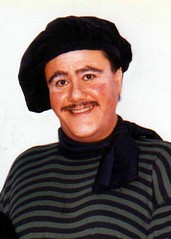 For those of you not in the D.C. metro area, there are a number of colleges showing the simulcast as well. More details are on WNO's Web site, but I think the schools are: Brown, Bryn Mawr, Cumberland School of Law, Duke, New York University, North Carolina School of the Arts, Ohio University, Princeton, Rice, Southern Virginia Higher Education Center, Temple, Tulane, Union College, U. S. Military Academy, Virginia Tech, Wellesley, and the Universities of Alabama, Arkansas, Colorado, Florida, Massachusetts–Amherst, North Carolina, Oklahoma, Richmond, Virginia and Washington.
For those of you not in the D.C. metro area, there are a number of colleges showing the simulcast as well. More details are on WNO's Web site, but I think the schools are: Brown, Bryn Mawr, Cumberland School of Law, Duke, New York University, North Carolina School of the Arts, Ohio University, Princeton, Rice, Southern Virginia Higher Education Center, Temple, Tulane, Union College, U. S. Military Academy, Virginia Tech, Wellesley, and the Universities of Alabama, Arkansas, Colorado, Florida, Massachusetts–Amherst, North Carolina, Oklahoma, Richmond, Virginia and Washington.Here's a pic of me the last time I sang in a Bohème production (no, I'm not singing in this one, and, unfortunately, I don't know any of the cast of this show). My makeup designer asked me to grow a moustache for the production, so I did that for nearly three months, and he still had to color it in with an eyebrow pencil!
Thursday, September 20, 2007
New theater

Last Saturday we went to the open house for the new Harmon Center for the Arts downtown across from the Verizon Center. The Harmon Center is the new second venue for the Shakespeare Theater Company. The company will continue to operate its original theater a block or two away, so they'll have two places for shows. The old theater holds about 450 and the new theater seats about 750.
The new facility is an office building that's been gutted and completely redone to include the new theater, performance space, concessions, patrons' lounge, box office, office space, and gift shop. The upper floors of the building are traditional office space for outside entities. The architectural design opened the building facade to the street and added a series of cantilevered floors that create more space overhanging the sidewalk, then enclosed it with a glass wall so the entire three floors of the theater lobby will be visible to the street.
I took a few photos inside the new theater, but as they were having a constant series of free performances during the day, flash was prohibited, so you'll have to deal with a little bit of blurriness from me trying to hold the camera still in a dark auditorium.
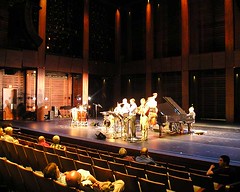
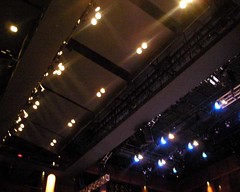
Above is a photo of the stage. It's rather open with no proscenium or curtain—part of the unfortunate modern trend in theater design to eliminate the "distance" between the action and the audience in an attempt to make live theater more "relevant" (whatever that means). In the second photo, you can see the fly space, which really isn't a fly space, as the lights and things are just hanging there out in the open.
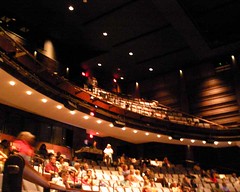
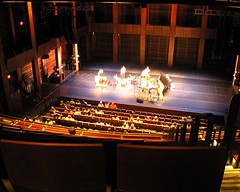
Next is a view of the house. The lower level actually has two levels, but I was standing on the side about midway, so you can see the lower seats, which are on a flatter floor. The balcony up above is quite steeply banked; you can see that in the second photo, taken from the back row of the balcony. The view of the stage from the balcony is actually quite good.
Brian was very excited about the new theater facility, since he is considering applying for a year long internship with the company for after he finishes his technical theater degree at Dartmouth next June.
Monday, September 10, 2007
Stuck
I was playing through my Tannhäuser score this afternoon, and now I can't get the Pilgrim's Chorus out of my head!
Thursday, September 6, 2007
Il maestro dorme
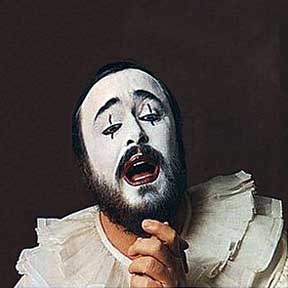
Twenty-five years ago, a fairly forgetable movie called Yes, Giorgio! played in Oklahoma City, telling the story of a opera star who loses his voice before an important concert, then falls in love with the doctor who treats him. The operaphiles—of which I was not yet one—were all excited because the main character was played by this fat Italian guy who was, apparently, one of their big opera stars.
We were just college students then, and, while we liked classical music and sang in school and church choirs, we weren't particularly well-versed in opera. Sure, there were a lot of opera melodies that were familiar tunes (thanks to Bugs Bunny and others), but we weren't exactly experts in the genre. But, off we went, and it was that night that I was first exposed to Luciano Pavarotti.
Also for the first time, I heard in that movie a little aria from a Puccini opera Turandot called "Nessun dorma"—None Shall Sleep. It was one of the songs from one of Pavarotti's standard roles as Prince Calàf, but it hadn't yet developed the "signature song" status it would get after the 1990 World Cup performance. And I liked it.
Nessun dorma! Nessun dorma! Tu pure, o Principessa, nella tua fredda stanza guardi le stelle che tremano d'amore e di speranza. Ma il mio mistero è chiuso in me, il nome mio nessun saprà! No, no, sulla tua bocca lo dirò, quando la luce splenderà! Ed il mio bacio scioglierà il silenzio che ti fa mia. Dilegua, o notte! Tramontate, stelle! Tramontate, stelle! All'alba vincerò! Vincerò! Vincerò!
None shall sleep! None shall sleep! Even you, o Princess, in your cold room, watch the stars, that tremble with love and with hope. But my secret is hidden within me, my name no one shall know. No, no, on your mouth I will tell it when the light shines. And my kiss will dissolve the silence that makes you mine! Vanish, o night! Set, stars! Set, stars! At dawn, I will win! I will win! I will win!
The performance was pretty phenomenal, and I was particularly intrigued with the ending: Pavarotti didn't sing "veen-chay-ro," but "vee-nah-chay-ro," adding a little shadow vowel syllable to his native Italian language, giving himself essentially a springboard to catapult him to that long, glorious high B that is the penultimate note of the aria. That's the way everyone sings it now.
Now that Pavarotti was on my radar screen, I started listening to his music, and marveling at his amazingly easy, pure tenor voice. There was never any struggle, never any pressure, never any pinched sound, never any heroic effort. He just floated those high notes on the air.
After that 1990 soccer game, it seems like everyone was a Pavarotti fan. In fact, it got to be next to impossible to get tickets to an opera or a concert when he was on the bill. Ticket prices skyrocketed—one Met gala had tickets as high as $1,875 each. Yet, it was worth it. As magnificent as his voice sounds on television or on a CD, there was nothing quite like hearing it live and in person.
The last time I heard Pavarotti in person was probably back in 1994 or 95 singing at the Metropolitan Opera in New York in a Verdi opera called I Lombardi. I almost didn't get to go, because the performance was long sold-out, and I wasn't able to pull any strings at the box office to get one, even at inflated prices. Fortuitously, on my flight to New York, I ran into Samuel Ramey—also en route to the Met for Lombardi, but to sing it—and bewailed my plight that I wouldn't be able to hear Sam sing because all the Pavarotti fans had bought up all the tickets. Sam said he'd take care of it, and he did: he got me a company pass that put me in the first balcony in a fabulous seat. After the long performance, I went backstage to Sam's dressing room to thank him for the ticket and get him to autograph my program. As I left, I saw this huge line going to Pavarotti's dressing room, so, even though we were only supposed to be backstage when we were on the "approved" guest lists, I decided to seize the moment, get in line, and meet il Maestro.
Once I was in the Presence, I was surprised to see how short he really is. When he is on stage, his voice and his personality made him larger than life, but that was merely an illusion. It was also so obvious that he was dying his eyebrows and beard dark, dark black, as though he wanted to avoid having to get another headshot taken, so he just changed himself to match the old photograph. He was quite patient and quite gracious as the endless fans all came to pay their respects and seek his signature. His staff had to encourage people to move along in the line and not monopolize his time. When it came time for me to greet him, he looked me up and down warily, then in his accented English said, "You sing?" I don't know how he would know to ask me that, but after my confession, he said, "Ah. Remember always to be to the music sincere."
Just a few hours ago, Pavarotti lost his battle with cancer. Today, no doubt, all the news agencies will offer retrospectives of his life and career, probably endlessly playing clips from "Nessun dorma" or "Che gelida manina." Certainly, he was the most important opera singer since Enrico Caruso, he was the modern opera superstar, he was the first cross-over musical artist, he was a leader in bringing opera to the American masses, he made "Nessun dorma" almost a household melody, he was the quintessential divo.
Calàf sings "none shall sleep," and ultimately declares that in his struggle with Princess Turandot, he will win—vincerò. Well, the cancer prevailed in this round with Pavarotti, but it didn't win. It didn't win at all, because that voice will live forever in the recordings and videos and the hearts and minds of all who heard and loved Luciano Pavarotti.
Resto nella pace, Luciano.
Thursday, August 30, 2007
Gay history makes it to the Smithsonian
In 1957, an astronomer working for the U.S. Army Map Service was fired for being homosexual. He pursed appeals and litigation to regain his job, but lost in an era when homosexuality was deemed to be "degeneracy" and something that made a person a security risk. That astronomer is Franklin Kameny, a Harvard Ph.D. and World War II Army veteran, who then launched a campaign to convince the U.S. Civil Service Commission to lift its ban on homosexuals in government service, a ban that was not lifted until 1975. In the meantime, Kameny became one of the most important gay civil rights leaders in the country, founding the Mattachine Society, an early gay activism group, and helping found the Gay Rights National Lobby, now known as the Human Rights Campaign (HRC). He was one of the leaders in lobbying the American Psychological Association to remove homosexuality as a "mental illness" and the American Bar Association in establishing legal rights for homosexuals.
Last year, Dr. Kameny, who is now in his 90s, contributed his half century's worth of files and memorabilia on the struggle for gay civil rights to the National Museum of American History at the Smithsonian Institution and to the Library of Congress.
This morning, my RSS feed picked up a story from The Advocate announcing a new exhibition from the Frank Kameny Collection on display at the Smithsonian through the end of October. So, this afternoon, I decided to wander over to the Smithsonian to see the exhibit. And, I was disappointed.
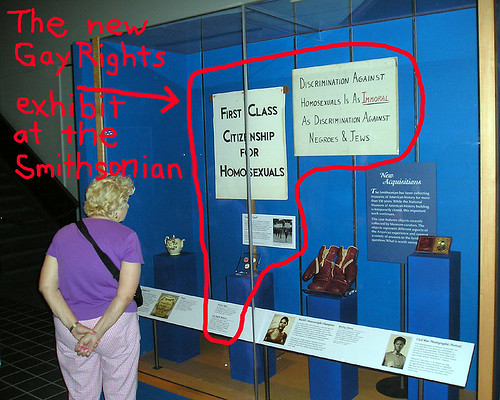
The "exhibit" consisted of just two protest posters and three buttons. But, I suppose I should be happy that there is this much on display at the Smithsonian where thousands of tourists could see the words and maybe, just maybe, give some thought to the matter.
 In another part of the museum, I ran across what was marked as a panel in the AIDS Memorial Quilt. Unfortunately, the display did little to convey the enormous emotional impact—or purpose—of the Quilt. I don't know how many of you have ever seen portions of the quilt, but usually when I see it, panels are laid out in a way that entirely covers the floor of a gymnasium or convention center. Each panel was made by the family and friends of a victim of HIV, and offers a memorial to that person and his (or her) life and interests.
In another part of the museum, I ran across what was marked as a panel in the AIDS Memorial Quilt. Unfortunately, the display did little to convey the enormous emotional impact—or purpose—of the Quilt. I don't know how many of you have ever seen portions of the quilt, but usually when I see it, panels are laid out in a way that entirely covers the floor of a gymnasium or convention center. Each panel was made by the family and friends of a victim of HIV, and offers a memorial to that person and his (or her) life and interests.
While at the museum, I had to visit the men's room. Interestingly, I was very self-conscious as to how wide my feet were apart in the stall, and then when someone came in and sat in the next stall, I became very concerned about not moving my toes—I'd changed into a pair of Birkenstocks before going to the museum, so they were very visible. Odd how current events have an impact on us, even in a museum with an exhibit on gay rights.
While I was in the neighborhood, I thought it would be comforting to visit a certain exhibit of those fundamental documents that provide our civil rights in this country, the Declaration of Independence and the Constitution of the United States, on display in very carefully constructed and controlled cases at the National Archives. They are getting very faded these days, especially the Declaration, but we all still know what they say and we have plenty of reproductions around. Nevertheless, it's always good to see the real thing.
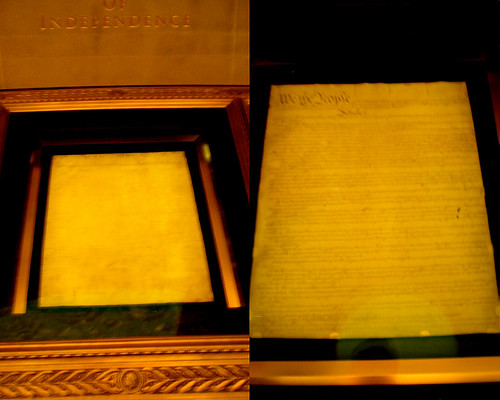
Last year, Dr. Kameny, who is now in his 90s, contributed his half century's worth of files and memorabilia on the struggle for gay civil rights to the National Museum of American History at the Smithsonian Institution and to the Library of Congress.
This morning, my RSS feed picked up a story from The Advocate announcing a new exhibition from the Frank Kameny Collection on display at the Smithsonian through the end of October. So, this afternoon, I decided to wander over to the Smithsonian to see the exhibit. And, I was disappointed.

The "exhibit" consisted of just two protest posters and three buttons. But, I suppose I should be happy that there is this much on display at the Smithsonian where thousands of tourists could see the words and maybe, just maybe, give some thought to the matter.
 In another part of the museum, I ran across what was marked as a panel in the AIDS Memorial Quilt. Unfortunately, the display did little to convey the enormous emotional impact—or purpose—of the Quilt. I don't know how many of you have ever seen portions of the quilt, but usually when I see it, panels are laid out in a way that entirely covers the floor of a gymnasium or convention center. Each panel was made by the family and friends of a victim of HIV, and offers a memorial to that person and his (or her) life and interests.
In another part of the museum, I ran across what was marked as a panel in the AIDS Memorial Quilt. Unfortunately, the display did little to convey the enormous emotional impact—or purpose—of the Quilt. I don't know how many of you have ever seen portions of the quilt, but usually when I see it, panels are laid out in a way that entirely covers the floor of a gymnasium or convention center. Each panel was made by the family and friends of a victim of HIV, and offers a memorial to that person and his (or her) life and interests.While at the museum, I had to visit the men's room. Interestingly, I was very self-conscious as to how wide my feet were apart in the stall, and then when someone came in and sat in the next stall, I became very concerned about not moving my toes—I'd changed into a pair of Birkenstocks before going to the museum, so they were very visible. Odd how current events have an impact on us, even in a museum with an exhibit on gay rights.
While I was in the neighborhood, I thought it would be comforting to visit a certain exhibit of those fundamental documents that provide our civil rights in this country, the Declaration of Independence and the Constitution of the United States, on display in very carefully constructed and controlled cases at the National Archives. They are getting very faded these days, especially the Declaration, but we all still know what they say and we have plenty of reproductions around. Nevertheless, it's always good to see the real thing.

Sunday, August 26, 2007
Oh, thank God, it's the Mormons!
Nearly fifty years ago, many in the country were asking whether or not John Kennedy could be trusted to be president of the United States because he was a Roman Catholic, and he might be subject to taking orders from the pope. This morning as I was sitting in St. Stephen's—a place where the Kennedy family often worshipped—I started thinking about that and the parallels of the current dilemma we have in the Republican Party with the upcoming 2008 presidential election.
What triggered this line of thinking is the fact that Friday night, we went to see the new movie September Dawn, the true story of how the Mormons in Utah slaughtered a group of 120 Arkansas pioneers on their way to California in 1857, and the "conspiracy theory" that orders for the massacre came from the highest levels of the Mormon Church, even from then-president Brigham Young himself.
Now, September Dawn purely as a movie wasn't really the best-made movie I've ever seen. Aside from some fine performances from Jon Voight as Bishop Samuelson and Terence Stamp as Brigham Young, the rest of the cast (mostly because of the script and direction) bounced between stilted and high school drama club. The movie was based on the few available details of the factual massacre, and the script writers took a great deal of artistic license to create a very predictable love story that dominated most of the movie, I guess to balance out the hard facts of church history, conspiring with the Indians, and killing men, women, and children. The editing is choppy, camera angles monotonous, and it was several minutes into the film and its jumping around from date to date that I finally figured out what was going on.
The one thing the movie did drive home, though, was the strong, controlling, dominating influence of religious fundamentalist fanasticism and what such zealots can do "in the name of God." Now, the Mormons certainly have no monopoly on fanaticism and murdering in the name of God. After all, the Catholics have been doing that for millennia (remember the Crusades? the Inquisition?), and the Protestants have continued it themselves for centuries (reformation wars, witch hunts, etc.). We're also seeing a lot of it these days with modern Muslims.
Fifty years ago, though, I would venture to say that most Catholics would be quick to question an order from the pope or some archbishop to go murder innocent people, and today in 2007, Catholics not only would question but would "tell them where to go." The papal control thing was never really a serious concern in 1960 with John Kennedy.
The Mormons, though, are completely another matter. Now, as a non-Mormon, I may not have all the details just right, but I think I understand the gist of things. I might also say that I have a number of friends and acquaintances who are Mormons, and I respect the family-centered commitment and uprightness of their church and membership, so I have no ax to grind against them. The Mormons have a president they believe is God's prophet on earth, and a high council of a dozen or so "apostles" they believe are also in direct communication with God. The Mormon Church is extremely hierarchical, with small, local groups being ruled by lay bishops who have pretty much absolute authority over the members of their wards. I know Mormons who have quit their jobs and moved to different towns to fulfill the orders of their bishop or higher church authorities, and others who have taken on volunteer positions or tasks even when they didn't really have time for them. Discipline and obedience are very highly prized standards in the Mormon Church. Certainly, they aren't the zealots they were in the mid-19th century and they don't go around killing their errant members anymore, but the rules and pressure for obedience are still there. And, thus, we have the source for the Republican's current dilemma: Mitt Romney.
If Governor Romney were to become President of the United States, if the highest councils of the Mormon Church were to tell him to do a particular thing, what would he do? Now, of course, Mr. Romney is going to say that he will fulfill his oath of office to the Constitution and to the People, and that will override anything the Mormon Church might want. Yet, what will really happen? I believe that even today, Mormons are acculturated to do what the church leadership tells them to do. If push comes to shove, my gut feeling is that Mr. Romney is going to do what his church tells him to do.
What is particularly interesting about the September Dawn movie is Governor Romney's ancestor's role in the massacre. His Mormon polygamist great-great-grandfather "stole" an Arkansas woman to make her one of his wives, but the woman's husband didn't take kindly to that, and killed the Romney progenitor. It is believed that revenge and "blood atonement" for his death was one of the primary motivators for the Utah massacre of the Arkansans. I hear that Governor Romney does not plan to see September Dawn.
There are many who are claiming that this movie was made solely for the purpose of embarrassing the Mormons and hindering Governor Romney's presidential campaign. I give that argument short shrift. The massacre is historical fact. Look at the date of the massacre, too: September 11, 1857. This is the sesquicentennial (a/k/a 150th anniversary) of the massacre. I hardly think that the Governor's detractors began planning this 150 years ago.
September Dawn isn't going to win any Academy Awards. It is a useful vehicle, though, to educate us about a sad chapter of American history and to remind us of the rules and traditions of a major religious organization in America. I don't believe the movie's purpose is to foment anti-Mormon sentiment or embarrass Romney any more than a movie about the 1507 historical incident when 30 "witches" were burned by the Spanish Inquisition would be anything more than a 500th anniversary observance of the event, and certainly not a movie attempting to drum up anti-Catholicism or embarrass the presidential campaign of Rudy Guiliani.
So, I take the movie on its face value. Release is pretty limited (it's only at one theater in all of Washington, D.C.!), so if its showing near you, consider seeing it, especially if you are unfamiliar with the Mormon Church. And, if you can't catch it this month, at least try to rent the DVD.
(By the way, the title of the post is a quote from the movie, when the Arkansans have been under siege and the Mormons show up to "help" them shortly before murdering all of them.)
What triggered this line of thinking is the fact that Friday night, we went to see the new movie September Dawn, the true story of how the Mormons in Utah slaughtered a group of 120 Arkansas pioneers on their way to California in 1857, and the "conspiracy theory" that orders for the massacre came from the highest levels of the Mormon Church, even from then-president Brigham Young himself.
Now, September Dawn purely as a movie wasn't really the best-made movie I've ever seen. Aside from some fine performances from Jon Voight as Bishop Samuelson and Terence Stamp as Brigham Young, the rest of the cast (mostly because of the script and direction) bounced between stilted and high school drama club. The movie was based on the few available details of the factual massacre, and the script writers took a great deal of artistic license to create a very predictable love story that dominated most of the movie, I guess to balance out the hard facts of church history, conspiring with the Indians, and killing men, women, and children. The editing is choppy, camera angles monotonous, and it was several minutes into the film and its jumping around from date to date that I finally figured out what was going on.
The one thing the movie did drive home, though, was the strong, controlling, dominating influence of religious fundamentalist fanasticism and what such zealots can do "in the name of God." Now, the Mormons certainly have no monopoly on fanaticism and murdering in the name of God. After all, the Catholics have been doing that for millennia (remember the Crusades? the Inquisition?), and the Protestants have continued it themselves for centuries (reformation wars, witch hunts, etc.). We're also seeing a lot of it these days with modern Muslims.
Fifty years ago, though, I would venture to say that most Catholics would be quick to question an order from the pope or some archbishop to go murder innocent people, and today in 2007, Catholics not only would question but would "tell them where to go." The papal control thing was never really a serious concern in 1960 with John Kennedy.
The Mormons, though, are completely another matter. Now, as a non-Mormon, I may not have all the details just right, but I think I understand the gist of things. I might also say that I have a number of friends and acquaintances who are Mormons, and I respect the family-centered commitment and uprightness of their church and membership, so I have no ax to grind against them. The Mormons have a president they believe is God's prophet on earth, and a high council of a dozen or so "apostles" they believe are also in direct communication with God. The Mormon Church is extremely hierarchical, with small, local groups being ruled by lay bishops who have pretty much absolute authority over the members of their wards. I know Mormons who have quit their jobs and moved to different towns to fulfill the orders of their bishop or higher church authorities, and others who have taken on volunteer positions or tasks even when they didn't really have time for them. Discipline and obedience are very highly prized standards in the Mormon Church. Certainly, they aren't the zealots they were in the mid-19th century and they don't go around killing their errant members anymore, but the rules and pressure for obedience are still there. And, thus, we have the source for the Republican's current dilemma: Mitt Romney.
If Governor Romney were to become President of the United States, if the highest councils of the Mormon Church were to tell him to do a particular thing, what would he do? Now, of course, Mr. Romney is going to say that he will fulfill his oath of office to the Constitution and to the People, and that will override anything the Mormon Church might want. Yet, what will really happen? I believe that even today, Mormons are acculturated to do what the church leadership tells them to do. If push comes to shove, my gut feeling is that Mr. Romney is going to do what his church tells him to do.
What is particularly interesting about the September Dawn movie is Governor Romney's ancestor's role in the massacre. His Mormon polygamist great-great-grandfather "stole" an Arkansas woman to make her one of his wives, but the woman's husband didn't take kindly to that, and killed the Romney progenitor. It is believed that revenge and "blood atonement" for his death was one of the primary motivators for the Utah massacre of the Arkansans. I hear that Governor Romney does not plan to see September Dawn.
There are many who are claiming that this movie was made solely for the purpose of embarrassing the Mormons and hindering Governor Romney's presidential campaign. I give that argument short shrift. The massacre is historical fact. Look at the date of the massacre, too: September 11, 1857. This is the sesquicentennial (a/k/a 150th anniversary) of the massacre. I hardly think that the Governor's detractors began planning this 150 years ago.
September Dawn isn't going to win any Academy Awards. It is a useful vehicle, though, to educate us about a sad chapter of American history and to remind us of the rules and traditions of a major religious organization in America. I don't believe the movie's purpose is to foment anti-Mormon sentiment or embarrass Romney any more than a movie about the 1507 historical incident when 30 "witches" were burned by the Spanish Inquisition would be anything more than a 500th anniversary observance of the event, and certainly not a movie attempting to drum up anti-Catholicism or embarrass the presidential campaign of Rudy Guiliani.
So, I take the movie on its face value. Release is pretty limited (it's only at one theater in all of Washington, D.C.!), so if its showing near you, consider seeing it, especially if you are unfamiliar with the Mormon Church. And, if you can't catch it this month, at least try to rent the DVD.
(By the way, the title of the post is a quote from the movie, when the Arkansans have been under siege and the Mormons show up to "help" them shortly before murdering all of them.)
Monday, August 13, 2007
Indian collections
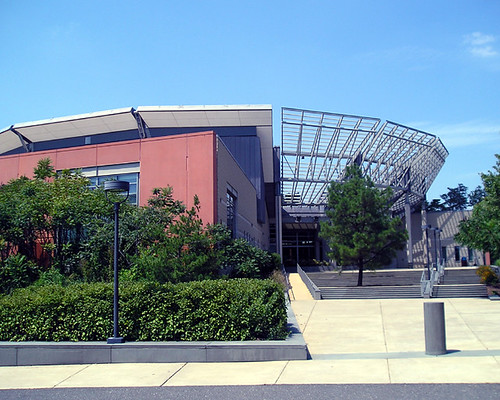
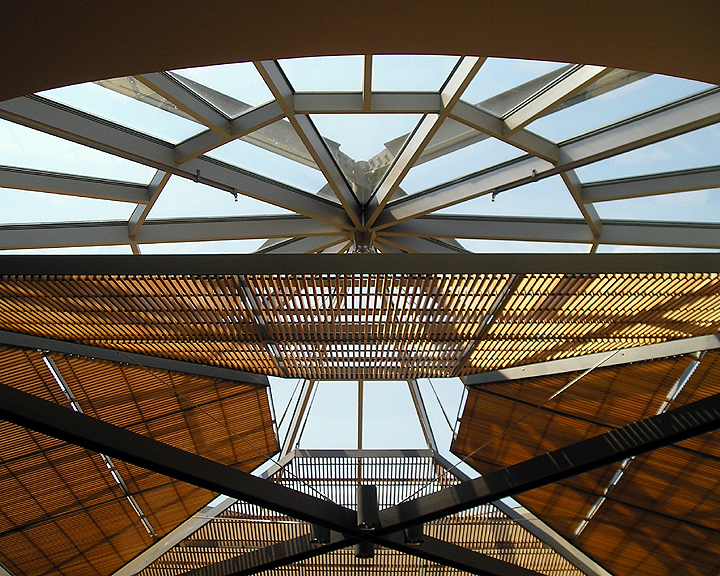 Over 800,000 artifacts and items of everyday use are housed in a state of the art research facility in Suitland, Maryland, for the National Museum of the American Indian at its Cultural Resources Center. The Center is the home for the things on exhibit at the museum in Washington, as well as its Indian museum in the Old Customs House in New York City, plus items on loan to museums around the world.
Over 800,000 artifacts and items of everyday use are housed in a state of the art research facility in Suitland, Maryland, for the National Museum of the American Indian at its Cultural Resources Center. The Center is the home for the things on exhibit at the museum in Washington, as well as its Indian museum in the Old Customs House in New York City, plus items on loan to museums around the world.The building itself is quite striking. Much like the museum in the District, it has been designed with Indian sensibilities in mind and echos traditional Indian architecture. While there is an impressive entry foyer, this is not really a building designed for tourists and visitors. It's a working facility for museum curators and staffers, plus armies of archivists, librarians, and conservation specialists. They do occasionally have visitors from other museums seeking materials for an exhibit and the occasional graduate student or researcher, so there are a few rooms to accommodate their needs.
The grounds are also landscaped in an "Indian" way. A large bronze statue of the famous Nez Perce leader Chief Joseph stands near the entrance. They have a small ceremonial circle in the woods behind the building, and a small room inside the building serves as a ceremonial room complete with sand fire pit in the floor.
 | 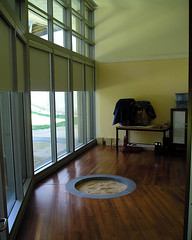 |
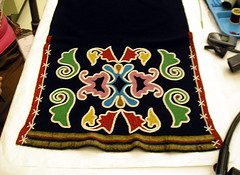 Conservation, repair, and preservation occupies a great deal of the center. They do things like put the pieces of old, shattered pottery back together, replace beads and porcupine quills on decorative pieces, and clean archeological finds. While I was in the textiles room, conservators were cleaning this beautiful Sac and Fox men's breechcloth with tweezers and a low-suction vacuum. It's made of navy blue wool broadcloth, edged with silk ribbon, and decorated with beads sewn on one at a time. The other end of the breechcloth has a similar beaded panel. The Sac and Fox, much like my tribe, makes use of a lot of abstract floral designs in their beadwork. I'm going to guess this piece comes from the Sac and Fox up in far northeastern Kansas (rather than the group in central Oklahoma for whom I used to be a supreme court justice) because they are making use of beads in that dusty rose color that is very, very popular with the Crow, a tribe in the northern plains.
Conservation, repair, and preservation occupies a great deal of the center. They do things like put the pieces of old, shattered pottery back together, replace beads and porcupine quills on decorative pieces, and clean archeological finds. While I was in the textiles room, conservators were cleaning this beautiful Sac and Fox men's breechcloth with tweezers and a low-suction vacuum. It's made of navy blue wool broadcloth, edged with silk ribbon, and decorated with beads sewn on one at a time. The other end of the breechcloth has a similar beaded panel. The Sac and Fox, much like my tribe, makes use of a lot of abstract floral designs in their beadwork. I'm going to guess this piece comes from the Sac and Fox up in far northeastern Kansas (rather than the group in central Oklahoma for whom I used to be a supreme court justice) because they are making use of beads in that dusty rose color that is very, very popular with the Crow, a tribe in the northern plains.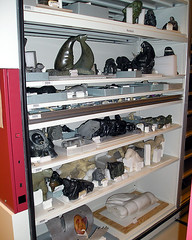 All of the archivists were on hand today to show off their shelves and shelves of items, and they were all very helpful and friendly. Now, this picture is of a rack of stone carvings done by Indians/Inuits/Eskimos from the Arctic regions, and they all have a very distinctive style to them. While talking to the staff member working the Arctic shelves, we got to talking about the clothing items they had in the racks and whether or not they required any special "cold" climate control to prevent deterioration. He said they tried to keep some of the things cooler and less humid than other things in the overall collections because a lot of the leather items had been tanned with urine!
All of the archivists were on hand today to show off their shelves and shelves of items, and they were all very helpful and friendly. Now, this picture is of a rack of stone carvings done by Indians/Inuits/Eskimos from the Arctic regions, and they all have a very distinctive style to them. While talking to the staff member working the Arctic shelves, we got to talking about the clothing items they had in the racks and whether or not they required any special "cold" climate control to prevent deterioration. He said they tried to keep some of the things cooler and less humid than other things in the overall collections because a lot of the leather items had been tanned with urine!These storage cabinets are all on rollers so the entire row of units can be moved flush side-to-side to save space between aisles. If one wants to see something in the middle of a group of rows, one has to wait until people are done elsewhere and the aisles are clear so everything can be moved to open up a new aisle where one wishes to work. They also go up probably twenty feet high, so there was a lot I couldn't see or get to without an appointment and a ladder.
I took several dozen pictures of various things, especially Great Lakes region tribes' beadwork and ribbonwork, plus some Seminole items. If you'd like to see them, click here to go to my Flickr album.
Monday, July 30, 2007
Late night ramblings
Well, I should be in bed, but I'm totally not sleepy.
Yesterday (Saturday) night, Ryan made me go with him and Robert to see The Simpsons Movie, even though I didn't want to go out. They seemed to have had an extra ticket and they didn't want to waste it (at $10.25 each!). Robert bought this absolutely enormous bucket of popcorn, but by the end of the movie, he and Ryan had only eaten maybe as much of a fourth of it.
The movie was funny and entertaining, though it had several questionable "PG-13" moments. There's a scene where Homer dares his son, Bart, to skateboard downtown and back naked (including a pedophilic moment displaying the boy's cartoon genitalia), and one where Marge interrupts Homer in what was implied to be a possible moment of beastiality. There is another scene where Homer is cared for by a buxom Indian medicine woman and the movie engages in a somewhat racist making fun of Indian culture and vision quests.
The movie did have some interesting explorations, including examination of Homer and Marge's marriage and the relationship between Homer and Bart. Lisa, meanwhile, was somewhat sidelined in this show, though she does get a mysterious, new boyfriend. Some of the humor in the show is very topical; it's really funny today in July 2007, but in five or ten years, will anybody get the joke? A few things are very esoteric—I caught a couple of things my compadres apparently missed. This is definitely a movie that will require multiple viewings for full appreciation.
Today (Sunday) has been rather an uneventful day. It rained much of the afternoon, so I spent a bunch of time trying to learn the accompaniment to Haydn's The Creation. I'm too out of practice; my fingers keep getting tangled up on all those runs of parallel thirds.
Yesterday (Saturday) night, Ryan made me go with him and Robert to see The Simpsons Movie, even though I didn't want to go out. They seemed to have had an extra ticket and they didn't want to waste it (at $10.25 each!). Robert bought this absolutely enormous bucket of popcorn, but by the end of the movie, he and Ryan had only eaten maybe as much of a fourth of it.
The movie was funny and entertaining, though it had several questionable "PG-13" moments. There's a scene where Homer dares his son, Bart, to skateboard downtown and back naked (including a pedophilic moment displaying the boy's cartoon genitalia), and one where Marge interrupts Homer in what was implied to be a possible moment of beastiality. There is another scene where Homer is cared for by a buxom Indian medicine woman and the movie engages in a somewhat racist making fun of Indian culture and vision quests.
The movie did have some interesting explorations, including examination of Homer and Marge's marriage and the relationship between Homer and Bart. Lisa, meanwhile, was somewhat sidelined in this show, though she does get a mysterious, new boyfriend. Some of the humor in the show is very topical; it's really funny today in July 2007, but in five or ten years, will anybody get the joke? A few things are very esoteric—I caught a couple of things my compadres apparently missed. This is definitely a movie that will require multiple viewings for full appreciation.
Today (Sunday) has been rather an uneventful day. It rained much of the afternoon, so I spent a bunch of time trying to learn the accompaniment to Haydn's The Creation. I'm too out of practice; my fingers keep getting tangled up on all those runs of parallel thirds.
Subscribe to:
Posts (Atom)
